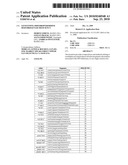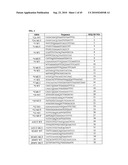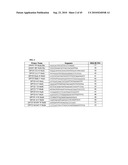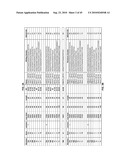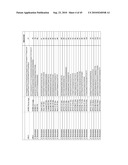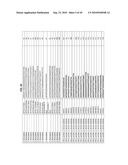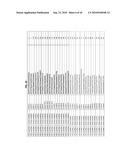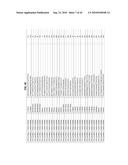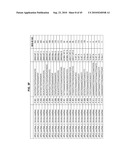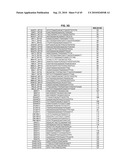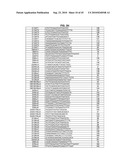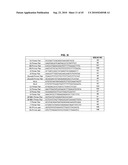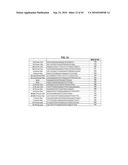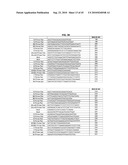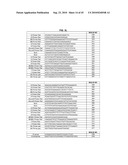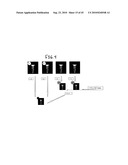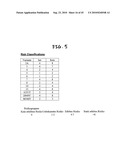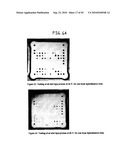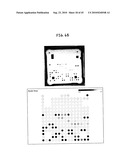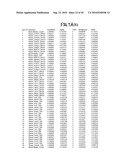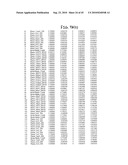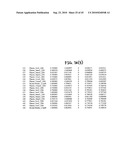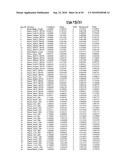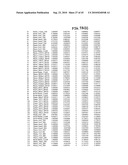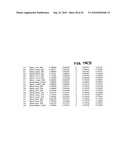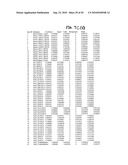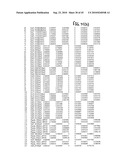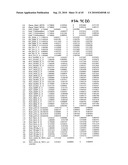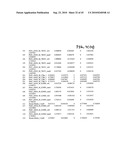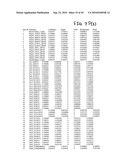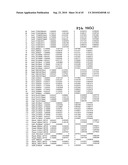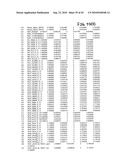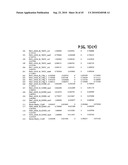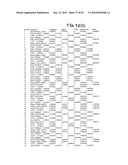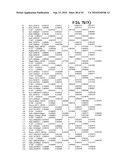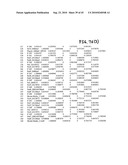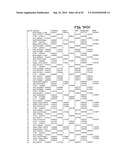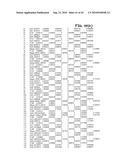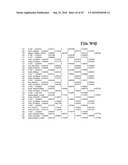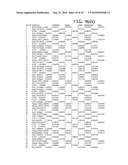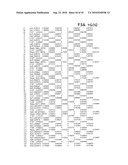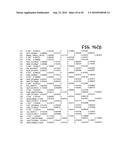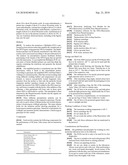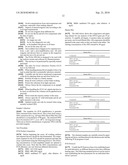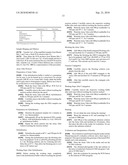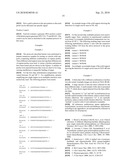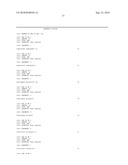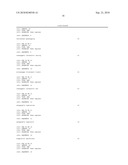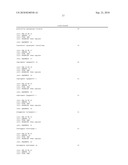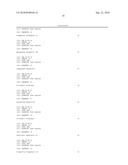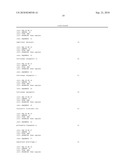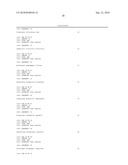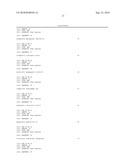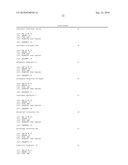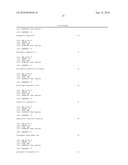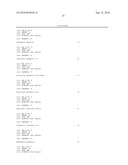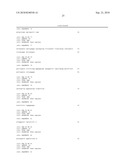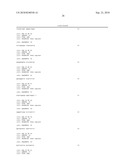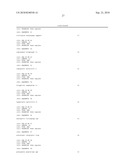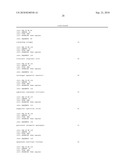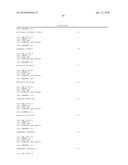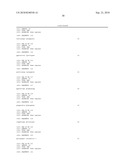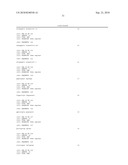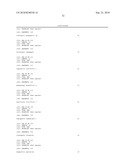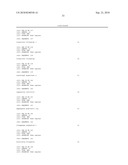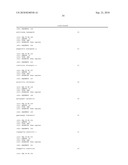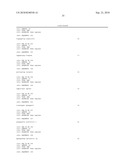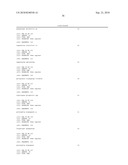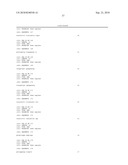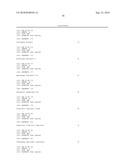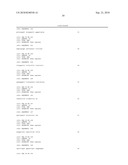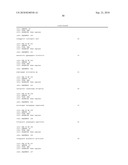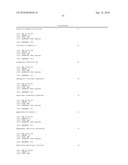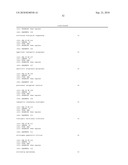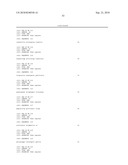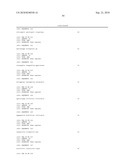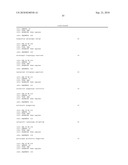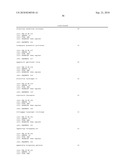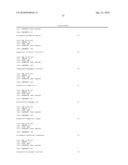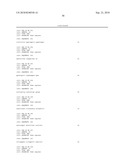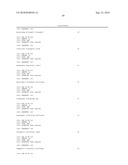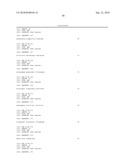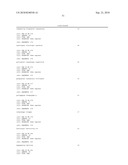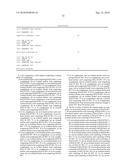Patent application title: Genotyping Dihydropyrimidine Dehydrogenase Deficiency
Inventors:
Moritz Eidens (Mainz, DE)
Stefan Prause (Mainz, DE)
Alexander Weise (Gensingen, DE)
Andreas Pfuetzner (Mainz, DE)
IPC8 Class: AC40B3004FI
USPC Class:
506 9
Class name: Combinatorial chemistry technology: method, library, apparatus method of screening a library by measuring the ability to specifically bind a target molecule (e.g., antibody-antigen binding, receptor-ligand binding, etc.)
Publication date: 2010-09-23
Patent application number: 20100240548
Claims:
1. A kit comprising a solid support comprising a capture probe set
comprising:(a) an isolated nucleic acid comprising SEQ ID NO: 1 or its
complement, (b) an isolated nucleic acid comprising SEQ ID NO: 2 or its
complement, (c) an isolated nucleic acid comprising SEQ ID NO: 3 or its
complement, (d) an isolated nucleic acid comprising SEQ ID NO: 4 or its
complement, (e) an isolated nucleic acid comprising SEQ ID NO: 5 or its
complement, (f) an isolated nucleic acid comprising SEQ ID NO: 6 or its
complement, (g) an isolated nucleic acid comprising SEQ ID NO: 7 or its
complement, (h) an isolated nucleic acid comprising SEQ ID NO: 8 or its
complement, (i) an isolated nucleic acid comprising SEQ ID NO: 9 or its
complement, (j) an isolated nucleic acid comprising SEQ ID NO: 10 or its
complement, (k) an isolated nucleic acid comprising SEQ ID NO: 11 or its
complement, (l) an isolated nucleic acid comprising SEQ ID NO:12 or its
complement, (m) an isolated nucleic acid comprising SEQ ID NO: 13 or its
complement, (n) an isolated nucleic acid comprising SEQ ID NO: 14 or its
complement, (o) an isolated nucleic acid comprising SEQ ID NO: 15 or its
complement, (p) an isolated nucleic acid comprising SEQ ID NO: 16 or its
complement, (q) an isolated nucleic acid comprising SEQ ID NO: 17 or its
complement, (r) an isolated nucleic acid comprising SEQ ID NO: 18 or its
complement, (s) an isolated nucleic acid comprising SEQ ID NO:19 or its
complement, (t) an isolated nucleic acid comprising SEQ ID NO: 20 or its
complement, (u) an isolated nucleic acid comprising SEQ ID NO: 21 or its
complement, (v) an isolated nucleic acid comprising SEQ ID NO: 22 or its
complement, (w) an isolated nucleic acid comprising SEQ ID NO: 23 or its
complement, (x) an isolated nucleic acid comprising SEQ ID NO: 24 or its
complement, (y) an isolated nucleic acid comprising SEQ ID NO: 25 or its
complement, (z) an isolated nucleic acid comprising SEQ ID NO: 26 or its
complement, (aa) an isolated nucleic acid comprising SEQ ID NO:27 or its
complement, (ab) an isolated nucleic acid comprising SEQ ID NO: 28 or its
complement, (ac) an isolated nucleic acid comprising SEQ ID NO: 29 or its
complement, (ad) an isolated nucleic acid comprising SEQ ID NO: 30 or its
complement, (ae) an isolated nucleic acid comprising SEQ ID NO: 31 or its
complement, (af) an isolated nucleic acid comprising SEQ ID NO: 32 or its
complement, (ag) an isolated nucleic acid comprising SEQ ID NO: 33 or its
complement, (ah) an isolated nucleic acid comprising SEQ ID NO: 34 or its
complement, (ai) an isolated nucleic acid comprising SEQ ID NO: 35 or its
complement, and (aj) a nucleic acid comprising SEQ ID NO: 36 or its
complement, wherein each of the isolated nucleic acids has a length of
about 18 to about 50 nucleic acids.
2. The kit of claim 1 wherein the capture probe set comprises: (a) an isolated nucleic acid consisting of SEQ ID NO: 1, (b) an isolated nucleic acid consisting of SEQ ID NO: 2, (c) an isolated nucleic acid consisting of SEQ ID NO: 3, (d) an isolated nucleic acid consisting of SEQ ID NO: 4, (e) an isolated nucleic acid consisting of SEQ ID NO:5, (f) an isolated nucleic acid consisting of SEQ ID NO: 6, (g) an isolated nucleic acid consisting of SEQ ID NO: 7, (h) an isolated nucleic acid consisting of SEQ ID NO: 8, (i) an isolated nucleic acid consisting of SEQ ID NO: 9, (j) an isolated nucleic acid consisting of SEQ ID NO: 10, (k) an isolated nucleic acid consisting of SEQ ID NO: 11, (l) an isolated nucleic acid consisting of SEQ ID NO: 12, (m) an isolated nucleic acid consisting of SEQ ID NO: 13, (n) an isolated nucleic acid consisting of SEQ ID NO: 14, (o) an isolated nucleic acid consisting of SEQ ID NO: 15, (p) an isolated nucleic acid consisting of SEQ ID NO: 16, (q) an isolated nucleic acid consisting of SEQ ID NO: 17, (r) an isolated nucleic acid consisting of SEQ ID NO: 18, (s) an isolated nucleic acid consisting of SEQ ID NO: 19, (t) an isolated nucleic acid consisting of SEQ ID NO: 20, (u) an isolated nucleic acid consisting of SEQ ID NO: 21, (v) an isolated nucleic acid consisting of SEQ ID NO: 22, (w) an isolated nucleic acid consisting of SEQ ID NO: 23, (x) an isolated nucleic acid consisting of SEQ ID NO: 24, (y) an isolated nucleic acid consisting of SEQ ID NO: 25, (z) an isolated nucleic acid consisting of SEQ ID NO: 26, (aa) an isolated nucleic acid consisting of SEQ ID NO: 27, (ab) an isolated nucleic acid consisting of SEQ ID NO: 28, (ac) an isolated nucleic acid consisting of SEQ ID NO: 29. (ad) an isolated nucleic acid consisting of SEQ ID NO: 30, (ae) an isolated nucleic acid consisting of SEQ ID NO: 31, (af) an isolated nucleic acid consisting of SEQ ID NO: 32, (ag) an isolated nucleic acid consisting of SEQ ID NO: 33, (ah) an isolated nucleic acid consisting of SEQ ID NO: 34, (ai) an isolated nucleic acid consisting of SEQ ID NO: 35, and (aj) a nucleic acid consisting of SEQ ID NO: 36.
3. The kit of claim 1 further comprising a primer set comprising: (a) an isolated nucleic acid comprising SEQ ID NO: 37 or its complement, (b) an isolated nucleic acid comprising SEQ ID NO: 38 or its complement, (c) an isolated nucleic acid comprising SEQ ID NO: 39 or its complement, (d) an isolated nucleic acid comprising SEQ ID NO: 40 or its complement, (e) an isolated nucleic acid comprising SEQ ID NO: 41 or its complement, (f) an isolated nucleic acid comprising SEQ ID NO: 42 or its complement, (g) an isolated nucleic acid comprising SEQ ID NO: 43 or its complement, (h) an isolated nucleic acid comprising SEQ ID NO: 44 or its complement, (i) an isolated nucleic acid comprising SEQ ID NO: 45 or its complement, (j) an isolated nucleic acid comprising SEQ ID NO: 46 or its complement, (k) an isolated nucleic acid comprising SEQ ID NO: 47 or its complement, (l) an isolated nucleic acid comprising SEQ ID NO: 48 or its complement, (m) an isolated nucleic acid comprising SEQ ID NO: 49 or its complement, (n) an isolated nucleic acid comprising SEQ ID NO: 50 or its complement, (o) an isolated nucleic acid comprising SEQ ID NO: 51 or its complement, and (p) an isolated nucleic acid comprising SEQ ID NO: 52 or its complement, wherein each of the isolated nucleic acids has a length of about 21 to about 50 nucleic acids.
4. The kit of claim 3 wherein the primer set comprises: (a) an isolated nucleic acid consisting of SEQ ID NO: 37, (b) an isolated nucleic acid consisting of SEQ ID NO:38, (c) an isolated nucleic acid consisting of SEQ ID NO: 39, (d) an isolated nucleic acid consisting of SEQ ID NO: 40, (e) an isolated nucleic acid consisting of SEQ ID NO: 41, (f) an isolated nucleic acid consisting of SEQ ID NO: 42, (g) an isolated nucleic acid consisting of SEQ ID NO: 43, (h) an isolated nucleic acid consisting of SEQ ID NO: 44, (i) an isolated nucleic acid consisting of SEQ ID NO: 45, (j) an isolated nucleic acid consisting of SEQ ID NO: 46, (k) an isolated nucleic acid consisting of SEQ ID NO: 47, (l) an isolated nucleic acid consisting of SEQ ID NO: 48, (m) an isolated nucleic acid consisting of SEQ ID NO: 49, (n) an isolated nucleic acid consisting of SEQ ID NO: 50, (o) an isolated nucleic acid consisting of SEQ ID NO: 51 and (p) an isolated nucleic acid consisting of SEQ ID NO: 52.
5. The kit of claim 3 wherein at least one of the isolated nucleic acids of the primer set comprises a detectable label.
6. The kit of claim 5 wherein the detectable label is biotin.
7. The kit of claim 6 further comprising a conjugated enzyme.
8. The kit of claim 7 further comprising a precipitating agent.
9. A method of detecting one or more polymorphisms in a nucleic acid comprising the DPYD gene, the method comprising:(a) generating a plurality of amplicons in a sample comprising the nucleic acid, wherein the generating step comprises contacting the sample with a primer set comprising (i) an isolated nucleic acid comprising SEQ ID NO: 37 or its complement, (ii) an isolated nucleic acid comprising SEQ ID NO: 38 or its complement, (iii) an isolated nucleic acid comprising SEQ ID NO: 39 or its complement, (iv) an isolated nucleic acid comprising SEQ ID NO: 40 or its complement, (v) an isolated nucleic acid comprising SEQ ID NO: 41 or its complement, (vi) an isolated nucleic acid comprising SEQ ID NO: 42 or its complement, (vii) an isolated nucleic acid comprising SEQ ID NO: 43 or its complement, (viii) an isolated nucleic acid comprising SEQ ID NO: 44 or its complement, (ix) an isolated nucleic acid comprising SEQ ID NO: 45 or its complement, (x) an isolated nucleic acid comprising SEQ ID NO: 46 or its complement, (xi) an isolated nucleic acid comprising SEQ ID NO: 47 or its complement, (xii) an isolated nucleic acid comprising SEQ ID NO: 48 or its complement, (xiii) an isolated nucleic acid comprising SEQ ID NO: 49 or its complement, (xiv) an isolated nucleic acid comprising SEQ ID NO: 50 or its complement, (xv) an isolated nucleic acid comprising SEQ ID NO: 51 or its complement, and (xvi) an isolated nucleic acid comprising SEQ ID NO: 52 or its complement, wherein each of the isolated nucleic acids has a length of about 21 to about 50 nucleic acids; and wherein each of the plurality of amplicons comprises a detectable label;(b) contacting the plurality of amplicons with the solid support of the kit of claim 1; and(c) detecting the presence or absence of the detectable label, thereby detecting one or more polymorphisms in the nucleic acid.
10. The method of claim 9 wherein the detecting step comprises contacting the sample with a conjugated enzyme.
11. The method of claim 10 wherein the detecting step comprises contacting the sample with a precipitating agent.
12. A method of determining dihydropyrimidine dehydrogenase genotype in a subject, the method comprising determining whether a nucleic acid in a sample from the subject is characterized by a plurality of DPYD alleles comprising *2A, *3, *4, *5, *6, *7, *8, *10, *12, *13, A551T, M166V and D949V.
13. The method of claim 12 wherein the plurality of DPYD alleles consists of *2A, *3, *4, *5, *6, *7, *8, *10, *12, *13, A551T, M166V and D949V.
14. A kit comprising:a) a capture probe that will hybridize under high stringency conditions to the complement of SEQ ID NO: 1 and contains G at a position corresponding to position 9 of SEQ ID NO: 1;b) a capture probe that will hybridize under high stringency conditions to the complement of SEQ ID NO: 2 and contains A at a position corresponding to position 9 of SEQ ID NO: 2;c) a capture probe that will hybridize under high stringency conditions to the complement of SEQ ID NO: 3 and contains G at a position corresponding to position 7 of SEQ ID NO: 3;d) a capture probe that will hybridize under high stringency conditions to the complement of SEQ ID NO: 4;e) a capture probe that will hybridize under high stringency conditions to the complement of SEQ ID NO: 5;f) a capture probe that will hybridize under high stringency conditions to the complement of SEQ ID NO: 6 and contains C at a position corresponding to position 12 of SEQ ID NO: 6;g) a capture probe that will hybridize under high stringency conditions to the complement of SEQ ID NO: 7 and contains C at a position corresponding to position 10 of SEQ ID NO: 7;h) a capture probe that will hybridize under high stringency conditions to the complement of SEQ ID NO: 8 and contains A at a position corresponding to position 6 of SEQ ID NO: 8;i) a capture probe that will hybridize under high stringency conditions to the complement of SEQ ID NO: 9 and contains T at a position corresponding to position 13 of SEQ ID NO: 9;j) a capture probe that will hybridize under high stringency conditions to the complement of SEQ ID NO: 10 and contains T at a position corresponding to position 15 of SEQ ID NO: 10;k) a capture probe that will hybridize under high stringency conditions to the complement of SEQ ID NO: 11 and contains C at a position corresponding to position 13 of SEQ ID NO: 11;l) a capture probe that will hybridize under high stringency conditions to the complement of SEQ ID NO: 12 and contains G at a position corresponding to position 7 of SEQ ID NO: 12;m) a capture probe that will hybridize under high stringency conditions to the complement of SEQ ID NO: 13 and contains G at a position corresponding to position 7 of SEQ ID NO: 13;n) a capture probe that will hybridize under high stringency conditions to the complement of SEQ ID NO: 14 and contains A at a position corresponding to position 6 of SEQ ID NO: 14;o) a capture probe that will hybridize under high stringency conditions to the complement of SEQ ID NO: 15 and contains ATGA at positions corresponding to positions 17-20 of SEQ ID NO: 15;p) a capture probe that will hybridize under high stringency conditions to the complement of SEQ ID NO: 16;q) a capture probe that will hybridize under high stringency conditions to the complement of SEQ ID NO: 17 and contains G at a position corresponding to position 6 of SEQ ID NO: 17;r) a capture probe that will hybridize under high stringency conditions to the complement of SEQ ID NO: 18 and contains G at a position corresponding to position 6 of SEQ ID NO: 18;s) a capture probe that will hybridize under high stringency conditions to the complement of SEQ ID NO: 19 and contains A at a position corresponding to position 6 of SEQ ID NO: 19;t) a capture probe that will hybridize under high stringency conditions to the complement of SEQ ID NO: 20 and contains C at a position corresponding to position 11 of SEQ ID NO: 20;u) a capture probe that will hybridize under high stringency conditions to the complement of SEQ ID NO: 21 and contains C at a position corresponding to position 13 of SEQ ID NO: 21;v) a capture probe that will hybridize under high stringency conditions to the complement of SEQ ID NO: 22 and contains A at a position corresponding to position 12 of SEQ ID NO: 22;w) a capture probe that will hybridize under high stringency conditions to the complement of SEQ ID NO: 23 and contains A at a position corresponding to position 11 of SEQ ID NO: 23;x) a capture probe that will hybridize under high stringency conditions to the complement of SEQ ID NO: 24 and contains G at a position corresponding to position 14 of SEQ ID NO: 24;y) a capture probe that will hybridize under high stringency conditions to the complement of SEQ ID NO: 25 and contains T at a position corresponding to position 17 of SEQ ID NO: 25;z) a capture probe that will hybridize under high stringency conditions to the complement of SEQ ID NO: 26 and contains A at a position corresponding to position 8 of SEQ ID NO: 26;aa) a capture probe that will hybridize under high stringency conditions to the complement of SEQ ID NO: 27 and contains G at a position corresponding to position 6 of SEQ ID NO: 27;ab) a capture probe that will hybridize under high stringency conditions to the complement of SEQ ID NO: 28 and contains C at a position corresponding to position 8 of SEQ ID NO: 28;ac) a capture probe that will hybridize under high stringency conditions to the complement of SEQ ID NO: 29 and contains G at a position corresponding to position 14 of SEQ ID NO: 29;ad) a capture probe that will hybridize under high stringency conditions to the complement of SEQ ID NO: 30 and contains G at a position corresponding to position 16 of SEQ ID NO: 30;ae) a capture probe that will hybridize under high stringency conditions to the complement of SEQ ID NO: 31 and contains A at a position corresponding to position 14 of SEQ ID NO: 31;af) a capture probe that will hybridize under high stringency conditions to the complement of SEQ ID NO: 32 and contains A at a position corresponding to position 12 of SEQ ID NO: 32;ag) a capture probe that will hybridize under high stringency conditions to the complement of SEQ ID NO: 33 and contains A at a position corresponding to position 12 of SEQ ID NO: 33;ah) a capture probe that will hybridize under high stringency conditions to the complement of SEQ ID NO: 34 and contains G at a position corresponding to position 12 of SEQ ID NO: 34;ai) a capture probe that will hybridize under high stringency conditions to the complement of SEQ ID NO: 35 and contains T at a position corresponding to position 15 of SEQ ID NO: 35; andaj) a capture probe that will hybridize under high stringency conditions to the complement of SEQ ID NO: 36 and contains T at a position corresponding to position 11 of SEQ ID NO: 36;
15. The kit of claim 14 wherein each of the capture probes has a length of about 18 to about 50 nucleic acids.
16. The kit of claim 15 wherein each of the capture probes has a length of about 18 to about 40 nucleic acids.
17. The kit of claim 16 wherein each of the capture probes has a length of about 18 to about 30 nucleic acids.
Description:
CROSS-REFERENCE TO RELATED APPLICATIONS
[0001]This application claims the benefit under 35 USC 119(e) of U.S. Application 61/121,833, filed Dec. 11, 2008, which is incorporated by reference in its entirety.
TECHNICAL FIELD
[0002]The invention relates to the field of pharmacogenetics and molecular detection.
BACKGROUND
[0003]Pharmacogenetics is the study of clinical testing of genetic variation that gives rise to differing response to drugs, and is increasingly important in the practice of medicine. Pharmacogenetic screening is especially important in oncology, as a small percentage of the patients receiving certain chemotherapeutic agents suffer from adverse drug reactions (ADRs), which may lead to severe toxicities or even death. One prominent example is the intolerance of 5-FU (Fluorouracil), which effect is also known as the pharmacogenetic syndrome "DPD deficiency." For example, tumor patients who are carriers of the most abundant exon 14 skipping mutation in the DPYD gene are at a significantly higher risk to suffer severe or mortal side effects during chemotherapy with 5-Fluorouracil or related prodrugs such as capecitabine. Similarly, a number of other mutations in the DPYD gene are correlated with or responsible for the occurrence of adverse drug reactions.sup.[1,2]
[0004]5-Fluorouracil (5-FU) is one of the most widely prescribed chemotherapeutic agents in the treatment of various cancers like colorectal cancer, breast cancer, pancreatic cancer, and head and neck cancer. In the normal case, the 5-FU dose becomes rapidly degraded in the patient's body.
[0005]The enzyme dihydropyrimidine dehydrogenase (DPD) is the rate-limiting enzyme in the degradation of pyrimidine bases like thymidine and uracil. DPD enzyme is also the main catalytic part involved in the degradation process of structurally related compounds like 5-Fluorouracil, capecitabine or other prodrugs.
[0006]There are >32 known sequence variations in the DPYD gene, which lead to structural aberrations in the enzyme which impair the enzymatic degradation function. The most prevalent and severe one is the exon 14 skipping mutation at position 1 of intron 14 in the DPYD gene. The consequence is a partial or complete deficiency of the DPD enzyme. Affected patients are not capable of degrading the 5-Fluorouracil fast enough or even at all and as a consequence severe or life threatening side effects may occur during the treatment. The problem can occur with homozygous or heterozygous carriers of the respective alleles.
[0007]Currently, several technologies are available for the genotyping of the human DPYD. Most important in this context is sequencing and real-time PCR. Sequencing is done according to Sanger's method, by applying fluorescence labelled ddNTPs, which incorporate into the DNA during amplification and thereby stop this reaction. After separation, each different nucleotide can be detected by a special reader using four different fluorophores. Real-time PCR is another method which can be used to detect mutations by means of melting curve analysis. The melting curve is related to fluorescence labelled, sequence specific probes, which melt differently depending on whether the target is a wild-type or a mutated DNA. The change of fluorescence signal can be detected by the real-time measuring instrument. Several protocols have been developed to detect different DPYD genotypes by these methods.
[0008]However, genotyping the DPYD in an easy, fast and cost-effective manner remains a challenge in the art. Just a small number of the relevant mutations can be detected quickly and cost-effectively by sequencing and real-time PCR. This small number of detectable alleles is not enough to obtain an accurate picture of the patient's drug metabolism risk profile. Due to the potentially serious consequences of deficiency, in DPD deficiency it is especially important to detect more than just one or two genetic polymorphisms in order to get comprehensive information about a patient's risk profile. No existing method can detect all relevant markers in one reaction in a cost effective manner.
SUMMARY OF INVENTION
[0009]It is aim of this invention to provide a multiplex test which detects all relevant genetic risk markers associated with DPD deficiency in one single reaction test. The composition of the selected markers is unique, as it contributes to a most accurate and comprehensive predictive risk profile for a patient.
[0010]With the aim to minimize these risks and to ensure safer therapy, the described set of mutation specific reagents covers genetic mutations which contribute to an increased toxicity risk during 5-FU chemotherapies, for all populations worldwide reported in the medical literature. Thus, a user obtains an exact and reliable medical statement of the patients predicted 5-FU tolerability and the associated risk profile of development of severe toxicities. The speed of the method is more than two fold better than competitive methods. Simple, compact, reasonably priced equipment can be used, facilitating the availability of testing in a larger number of laboratories. Since the macroarray chip is integrated into a common 1.5 mL lab tube, no expensive specialized equipment has to be purchased by the laboratory and lab personnel needs no special training
[0011]Furthermore, due to the utilization of a precipitation reaction for detection instead of fluorescence, as is done with the competitive technologies described above, reagents are much lower cost. Moreover, genotyping results can be read out by a cost-effective reader or a microscope, and since detection is principally based on colorimetry, no expensive fluorescence base detection system has to be used.
[0012]The specific design of the probes enables the detection of all described alleles in one single chip, while the specialized design of multiple multiplex primer pairs for PCR allows all the mutation detection reactions to be run in one single tube. Thus, the process of genotyping is less difficult and faster than it has ever been.
[0013]Accordingly, in one aspect, the invention provides a kit comprising a solid support comprising a capture probe set comprising: (a) an isolated nucleic acid comprising SEQ ID NO: 1 or its complement, (b) an isolated nucleic acid comprising SEQ ID NO: 2 or its complement, (c) an isolated nucleic acid comprising SEQ ID NO: 3 or its complement, (d) an isolated nucleic acid comprising SEQ ID NO: 4 or its complement, (e) an isolated nucleic acid comprising SEQ ID NO: 5 or its complement, (f) an isolated nucleic acid comprising SEQ ID NO: 6 or its complement, (g) an isolated nucleic acid comprising SEQ ID NO: 7 or its complement, (h) an isolated nucleic acid comprising SEQ ID NO: 8 or its complement, (i) an isolated nucleic acid comprising SEQ ID NO: 9 or its complement, (j) an isolated nucleic acid comprising SEQ ID NO: 10 or its complement, (k) an isolated nucleic acid comprising SEQ ID NO: 11 or its complement, (l) an isolated nucleic acid comprising SEQ ID NO: 12 or its complement, (m) an isolated nucleic acid comprising SEQ ID NO: 13 or its complement, (n) an isolated nucleic acid comprising SEQ ID NO: 14 or its complement, (o) an isolated nucleic acid comprising SEQ ID NO: 15 or its complement, (p) an isolated nucleic acid comprising SEQ ID NO: 16 or its complement, (q) an isolated nucleic acid comprising SEQ ID NO: 17 or its complement, (r) an isolated nucleic acid comprising SEQ ID NO: 18 or its complement, (s) an isolated nucleic acid comprising SEQ ID NO: 19 or its complement, (t) an isolated nucleic acid comprising SEQ ID NO: 20 or its complement, (u) an isolated nucleic acid comprising SEQ ID NO: 21 or its complement, (v) an isolated nucleic acid comprising SEQ ID NO: 22 or its complement, (w) an isolated nucleic acid comprising SEQ ID NO: 23 or its complement, (x) an isolated nucleic acid comprising SEQ ID NO: 24 or its complement, (y) an isolated nucleic acid comprising SEQ ID NO: 25 or its complement, (z) an isolated nucleic acid comprising SEQ ID NO: 26 or its complement, (aa) an isolated nucleic acid comprising SEQ ID NO: 27 or its complement, (ab) an isolated nucleic acid comprising SEQ ID NO: 28 or its complement, (ac) an isolated nucleic acid comprising SEQ ID NO: 29 or its complement, (ad) an isolated nucleic acid comprising SEQ ID NO: 30 or its complement, (ae) an isolated nucleic acid comprising SEQ ID NO: 31 or its complement, (af) an isolated nucleic acid comprising SEQ ID NO: 32 or its complement, (ag) an isolated nucleic acid comprising SEQ ID NO: 33 or its complement, (ah) an isolated nucleic acid comprising SEQ ID NO: 34 or its complement, (ai) an isolated nucleic acid comprising SEQ ID NO: 35 or its complement, and (aj) a nucleic acid comprising SEQ ID NO: 36 or its complement, wherein each of the isolated nucleic acids has a length of about 18 to about 50 nucleic acids.
[0014]In one embodiment, the capture probe set comprises: (a) an isolated nucleic acid consisting of SEQ ID NO: 1, (b) an isolated nucleic acid consisting of SEQ ID NO: 2, (c) an isolated nucleic acid consisting of SEQ ID NO: 3, (d) an isolated nucleic acid consisting of SEQ ID NO: 4, (e) an isolated nucleic acid consisting of SEQ ID NO: 5, (f) an isolated nucleic acid consisting of SEQ ID NO: 6, (g) an isolated nucleic acid consisting of SEQ ID NO: 7, (h) an isolated nucleic acid consisting of SEQ ID NO: 8, (i) an isolated nucleic acid consisting of SEQ ID NO: 9, (j) an isolated nucleic acid consisting of SEQ ID NO: 10, (k) an isolated nucleic acid consisting of SEQ ID NO: 11, (l) an isolated nucleic acid consisting of SEQ ID NO: 12, (m) an isolated nucleic acid consisting of SEQ ID NO: 13, (n) an isolated nucleic acid consisting of SEQ ID NO: 14, (o) an isolated nucleic acid consisting of SEQ ID NO: 15, (p) an isolated nucleic acid consisting of SEQ ID NO: 16, (q) an isolated nucleic acid consisting of SEQ ID NO: 17, (r) an isolated nucleic acid consisting of SEQ ID NO: 18, (s) an isolated nucleic acid consisting of SEQ ID NO: 19, (t) an isolated nucleic acid consisting of SEQ ID NO: 20, (u) an isolated nucleic acid consisting of SEQ ID NO: 21, (v) an isolated nucleic acid consisting of SEQ ID NO: 22, (w) an isolated nucleic acid consisting of SEQ ID NO: 23, (x) an isolated nucleic acid consisting of SEQ ID NO: 24, (y) an isolated nucleic acid consisting of SEQ ID NO: 25, (z) an isolated nucleic acid consisting of SEQ ID NO: 26, (aa) an isolated nucleic acid consisting of SEQ ID NO: 27, (ab) an isolated nucleic acid consisting of SEQ ID NO: 28, (ac) an isolated nucleic acid consisting of SEQ ID NO: 29, (ad) an isolated nucleic acid consisting of SEQ ID NO: 30, (ae) an isolated nucleic acid consisting of SEQ ID NO: 31, (af) an isolated nucleic acid consisting of SEQ ID NO: 32, (ag) an isolated nucleic acid consisting of SEQ ID NO: 33, (ah) an isolated nucleic acid consisting of SEQ ID NO: 34, (ai) an isolated nucleic acid consisting of SEQ ID NO: 35, and (aj) a nucleic acid consisting of SEQ ID NO: 36.
[0015]In one embodiment, the kit further comprises a primer set comprising: (a) an isolated nucleic acid comprising SEQ ID NO: 37 or its complement, (b) an isolated nucleic acid comprising SEQ ID NO: 38 or its complement, (c) an isolated nucleic acid comprising SEQ ID NO: 39 or its complement, (d) an isolated nucleic acid comprising SEQ ID NO: 40 or its complement, (e) an isolated nucleic acid comprising SEQ ID NO: 41 or its complement, (f) an isolated nucleic acid comprising SEQ ID NO: 42 or its complement, (g) an isolated nucleic acid comprising SEQ ID NO: 43 or its complement, (h) an isolated nucleic acid comprising SEQ ID NO: 44 or its complement, (i) an isolated nucleic acid comprising SEQ ID NO: 45 or its complement, (j) an isolated nucleic acid comprising SEQ ID NO: 46 or its complement, (k) an isolated nucleic acid comprising SEQ ID NO: 47 or its complement, (l) an isolated nucleic acid comprising SEQ ID NO: 48 or its complement, (m) an isolated nucleic acid comprising SEQ ID NO: 49 or its complement, (n) an isolated nucleic acid comprising SEQ ID NO: 50 or its complement, (o) an isolated nucleic acid comprising SEQ ID NO: 51 or its complement, and an isolated nucleic acid comprising SEQ ID NO: 52 or its complement, wherein each of the isolated nucleic acids has a length of about 21 to about 50 nucleic acids.
[0016]In one embodiment, the primer set comprises: (a) an isolated nucleic acid consisting of SEQ ID NO: 37, (b) an isolated nucleic acid consisting of SEQ ID NO: 38, (c) an isolated nucleic acid consisting of SEQ ID NO: 39, (d) an isolated nucleic acid consisting of SEQ ID NO: 40, (e) an isolated nucleic acid consisting of SEQ ID NO: 41, (f) an isolated nucleic acid consisting of SEQ ID NO: 42, (g) an isolated nucleic acid consisting of SEQ ID NO: 43, (h) an isolated nucleic acid consisting of SEQ ID NO: 44, (i) an isolated nucleic acid consisting of SEQ ID NO: 45, (j) an isolated nucleic acid consisting of SEQ ID NO: 46, (k) an isolated nucleic acid consisting of SEQ ID NO: 47, (l) an isolated nucleic acid consisting of SEQ ID NO: 48, (m) an isolated nucleic acid consisting of SEQ ID NO: 49, (n) an isolated nucleic acid consisting of SEQ ID NO: 50, (o) an isolated nucleic acid consisting of SEQ ID NO: 51 and (p) an isolated nucleic acid consisting of SEQ ID NO: 52.
[0017]In one embodiment, at least one of the isolated nucleic acids of the primer set comprises a detectable label.
[0018]In one embodiment, the detectable label is biotin.
[0019]In one embodiment, the kit further comprises a conjugated enzyme.
[0020]In one embodiment, the kit further comprises a precipitating agent.
[0021]In one aspect, the invention provides a method of detecting one or more polymorphisms in a nucleic acid comprising the DPYD gene, the method comprising: (a) generating a plurality of amplicons in a sample comprising the nucleic acid, wherein the generating step comprises contacting the sample with the primer set of a kit of the invention and wherein each of the plurality of amplicons comprises a detectable label; (b) contacting the plurality of amplicons with the solid support of a kit of the invention; and (c) detecting the presence or absence of the detectable label, thereby detecting one or more polymorphisms in the nucleic acid
[0022]In one embodiment, detecting step comprises contacting the sample with a conjugated enzyme.
[0023]In one embodiment, the detecting step comprises contacting the sample with a precipitating agent.
[0024]In one aspect, the invention provides a method of determining dihydropyrimidine dehydrogenase genotype in a subject, the method comprising determining whether a nucleic acid in a sample from the subject is characterized by a plurality of DPYD alleles comprising *2A, *3, *4, *5, *6, *7, *8, *10, *12, *13, A551T, M166V and D949V.
[0025]In one embodiment, the plurality of DPYD alleles consists of *2A, *3, *4, *5, *6, *7, *8, *10, *12, *13, A551T, M166V and D949V.
[0026]In one aspect, the invention provides a kit comprising: a) a capture probe that will hybridize under high stringency conditions to the complement of SEQ ID NO: 1 and contains G at a position corresponding to position 9 of SEQ ID NO: 1; b) a capture probe that will hybridize under high stringency conditions to the complement of SEQ ID NO: 2 and contains A at a position corresponding to position 9 of SEQ ID NO: 2; c) a capture probe that will hybridize under high stringency conditions to the complement of SEQ ID NO: 3 and contains G at a position corresponding to position 7 of SEQ ID NO: 3; d) a capture probe that will hybridize under high stringency conditions to the complement of SEQ ID NO: 4; e) a capture probe that will hybridize under high stringency conditions to the complement of SEQ ID NO: 5; f) a capture probe that will hybridize under high stringency conditions to the complement of SEQ ID NO: 6 and contains C at a position corresponding to position 12 of SEQ ID NO: 6; g) a capture probe that will hybridize under high stringency conditions to the complement of SEQ ID NO: 7 and contains C at a position corresponding to position 10 of SEQ ID NO: 7; h) a capture probe that will hybridize under high stringency conditions to the complement of SEQ ID NO: 8 and contains A at a position corresponding to position 6 of SEQ ID NO: 8; i) a capture probe that will hybridize under high stringency conditions to the complement of SEQ ID NO: 9 and contains T at a position corresponding to position 13 of SEQ ID NO: 9; j) a capture probe that will hybridize under high stringency conditions to the complement of SEQ ID NO: 10 and contains T at a position corresponding to position 15 of SEQ ID NO: 10; k) a capture probe that will hybridize under high stringency conditions to the complement of SEQ ID NO: 11 and contains C at a position corresponding to position 13 of SEQ ID NO: 11; l) a capture probe that will hybridize under high stringency conditions to the complement of SEQ ID NO: 12 and contains G at a position corresponding to position 7 of SEQ ID NO: 12; m) a capture probe that will hybridize under high stringency conditions to the complement of SEQ ID NO: 13 and contains G at a position corresponding to position 7 of SEQ ID NO: 13; n) a capture probe that will hybridize under high stringency conditions to the complement of SEQ ID NO: 14 and contains A at a position corresponding to position 6 of SEQ ID NO: 14; o) a capture probe that will hybridize under high stringency conditions to the complement of SEQ ID NO: 15 and contains ATGA at positions corresponding to positions 17-20 of SEQ ID NO: 15; p) a capture probe that will hybridize under high stringency conditions to the complement of SEQ ID NO: 16; q) a capture probe that will hybridize under high stringency conditions to the complement of SEQ ID NO: 17 and contains G at a position corresponding to position 6 of SEQ ID NO: 17; r) a capture probe that will hybridize under high stringency conditions to the complement of SEQ ID NO: 18 and contains G at a position corresponding to position 6 of SEQ ID NO: 18; s) a capture probe that will hybridize under high stringency conditions to the complement of SEQ ID NO: 19 and contains A at a position corresponding to position 6 of SEQ ID NO: 19; t) a capture probe that will hybridize under high stringency conditions to the complement of SEQ ID NO: 20 and contains C at a position corresponding to position 11 of SEQ ID NO: 20; u) a capture probe that will hybridize under high stringency conditions to the complement of SEQ ID NO: 21 and contains C at a position corresponding to position 13 of SEQ ID NO: 21; v) a capture probe that will hybridize under high stringency conditions to the complement of SEQ ID NO: 22 and contains A at a position corresponding to position 12 of SEQ ID NO: 22; w) a capture probe that will hybridize under high stringency conditions to the complement of SEQ ID NO: 23 and contains A at a position corresponding to position 11 of SEQ ID NO: 23; x) a capture probe that will hybridize under high stringency conditions to the complement of SEQ ID NO: 24 and contains G at a position corresponding to position 14 of SEQ ID NO: 24; y) a capture probe that will hybridize under high stringency conditions to the complement of SEQ ID NO: 25 and contains T at a position corresponding to position 17 of SEQ ID NO: 25; z) a capture probe that will hybridize under high stringency conditions to the complement of SEQ ID NO: 26 and contains A at a position corresponding to position 8 of SEQ ID NO: 26; aa) a capture probe that will hybridize under high stringency conditions to the complement of SEQ ID NO: 27 and contains G at a position corresponding to position 6 of SEQ ID NO: 27; ab) a capture probe that will hybridize under high stringency conditions to the complement of SEQ ID NO: 28 and contains C at a position corresponding to position 8 of SEQ ID NO: 28; ac) a capture probe that will hybridize under high stringency conditions to the complement of SEQ ID NO: 29 and contains G at a position corresponding to position 14 of SEQ ID NO: 29; ad) a capture probe that will hybridize under high stringency conditions to the complement of SEQ ID NO: 30 and contains G at a position corresponding to position 16 of SEQ ID NO: 30; ae) a capture probe that will hybridize under high stringency conditions to the complement of SEQ ID NO: 31 and contains A at a position corresponding to position 14 of SEQ ID NO: 31; af) a capture probe that will hybridize under high stringency conditions to the complement of SEQ ID NO: 32 and contains A at a position corresponding to position 12 of SEQ ID NO: 32; ag) a capture probe that will hybridize under high stringency conditions to the complement of SEQ ID NO: 33 and contains A at a position corresponding to position 12 of SEQ ID NO: 33; ah) a capture probe that will hybridize under high stringency conditions to the complement of SEQ ID NO: 34 and contains G at a position corresponding to position 12 of SEQ ID NO: 34; ai) a capture probe that will hybridize under high stringency conditions to the complement of SEQ ID NO: 35 and contains T at a position corresponding to position 15 of SEQ ID NO: 35; and aj) a capture probe that will hybridize under high stringency conditions to the complement of SEQ ID NO: 36 and contains T at a position corresponding to position 11 of SEQ ID NO: 36.
[0027]In one embodiment, each of the capture probes has a length of about 18 to about 50 nucleic acids.
[0028]In one embodiment, each of the capture probes has a length of about 18 to about 40 nucleic acids.
[0029]In one embodiment, each of the capture probes has a length of about 18 to about 30 nucleic acids.
BRIEF DESCRIPTION OF DRAWINGS
[0030]FIG. 1 shows sequences of probes that are useful for genotyping various DPYD alleles. The underlined nucleic acid corresponds to the nucleic acid at the "interrogation position" of the probe, which is used to determine the nucleic acid at the "detection position" in the DPYD gene or a fragment thereof. These terms are defined herein. As will be understood by those of skill in the art, determining a SNP at a detection position can comprise determining the nucleic acid found in a wild-type allele or the variant allele in either sense or antisense strand. As will also be understood, an interrogation position might not be defined in a probe testing for a deletion mutant.
[0031]FIG. 2 shows sequences of primers that are useful for genotyping various DPYD alleles. These primers can be used in four separate PCR reactions as follows and described below: Tube 1: 2A3, M166V, D949V (and 12, not shown in this table); Tube 2: 6, 8, Multi; Tube 3: 7; Tube 4: 10.
[0032]FIGS. 3A-3L show additional probes and primers that are useful for genotyping various DPYD alleles.
[0033]FIG. 4 shows a schematic for sample merging and dilution.
[0034]FIG. 5 shows how to interpret genotype results using a risk classification into 4 different groups. Each detected variant has a number. The higher the number, the higher the resulting risk. For example a patient with *1/*2A and *1/D949V has the values 4+4, resulting in the highest risk group.
[0035]FIGS. 6A-6F show images of three different chips tested. FIG. 6A shows one type of chip, FIGS. 6B and 6C show another type and FIG. 6D-6F show a third.
[0036]FIGS. 7A-7G show data collected for each of the three different types of chips.
DESCRIPTION OF EMBODIMENTS
I. Overview
[0037]The present invention provides compositions and methods for detecting the presence or absence of single nucleotide polymorphisms (SNPs; either alone or in any combination) in a dihydropyrimidine dehydrogenase (DPYD or DPD) gene. The investigated variations are connected to a decrease in (or absence of) DPD enzyme activity, which in turn leads to an increased risk for severe side effects and toxicities during a 5-Fluorouracil (5-FU) containing chemotherapy. 5-FU is a cytostatic drug that is routinely used for the treatment of many solid tumours.
[0038]Next to age, gender and environmental influences such like diet and co-medication, there are genetic factors that have a major impact on the catalytic activity of many enzymes. It is known that patients with decreased or totally absent function of the DPYD enzyme are at a higher risk to develop severe to lethal side effects upon chemotherapy with 5-Fluorouracil. Those risks range between grades 3-4 according to the WHO.
[0039]Analysis of the DPYD gene can help to reduce the risk of 5-FU related toxicities by anticipating the catalytic function of the DPYD enzyme for each individual patient. With this assay, patients bearing variants leading to a decreased enzyme activity can be identified prior to therapy initiation and can be treated accordingly with lower doses or alternative medications if applicable. Of all patients bearing one of the variants and treated with 5-FU, more than 40% will experience severe side effects.
[0040]As many cases of 5-FU related side effects can be explained by mutations in the DPYD gene, genotyping of those variants can help to optimize and individualize chemotherapies to prevent undesired effects and lower the costs that emerge from prolonged hospitalization and the treatment of adverse reactions.
[0041]No test exists which predicts the risk for the occurrence of severe side effects during a 5-FU chemotherapy in the way covered by the panel of SNPs in this invention.
[0042]The combinations of SNPs probed by the invention include the most clinically relevant mutations that are highly predictive for DPD deficiency in a subject, including, but not limited to, *2A, *3, *4, *5, *6, *7, *8, *10, *12, *13, A551T, M166V and D949V, all of which are described in further detail below. Other SNPs can be detected, such as *9A. The set used in the present invention can optionally include or exclude any of these SNPs. Thus, by probing for the presence of the various combinations of SNPs described herein, the practitioner can determine the degree of DPD deficiency in a subject and hence the subject's ability to tolerate certain chemotherapeutic drugs, such as 5-fluorouracil, which are metabolized by DPD.
[0043]The relevant SNPs are detected through multiplex methods of the invention that allow for the fast, easy and cost-effective determination of genetic mutations. A number of probes (referred to as "capture probes", as described below) and primers have been specially developed for this purpose and are described herein. Generally, the capture probes of the invention are attached to a solid support, to form an array. Capture probes are designed to bind to the area of the sequence containing the SNP location: in general, one capture probe is bound at a first location on the array which selectively binds to the target sequence containing the wild-type allele with a second capture probe at a second location that selectively binds to a target sequence containing a variant allele. (In some cases, there may be additional capture probes to the same SNP if there are either different wild-type alleles or different variants).
[0044]The primers of the invention are used in amplification reactions to generate amplicons corresponding to portions of the DPD gene containing a position at which a SNP potentially occurs. As is more fully outlined below, the target sequence (e.g. the amplicon) comprises a position for which sequence information is desired, generally referred to herein as the "detection position". As used herein, the base in the capture probe which basepairs with the detection position base in a hybrid is termed the "interrogation position".
[0045]The amplicons comprise a detectable label, which is generally added in one of two ways: either by pre-labeling the primers, resulting in labeled amplicons, or, in the case where PCR is used, by including labeled dNTPs during the amplification reaction; in either case, the resulting amplicon has a label. This label can be a direct or indirect label as more fully outlined below. In some embodiments, the indirect label is biotin, and a secondary label comprising a streptavidin-enzyme conjugate is added, such as a horseradish peroxidase conjugate, which binds to the detectable label and generates a visible precipitate upon addition of a precipitating agent. The solid supports, primers and detection reagents that are useful for detecting the DPD polymorphisms described herein can be conveniently assembled into relatively cost-effective kits.
II. Samples
[0046]Accordingly, the present invention provides compositions and methods for detecting the presence or absence of target nucleic acid sequences, particularly DPYD SNP sequences, in a sample. As will be appreciated by those in the art, the sample solution may comprise any number of things, including, but not limited to, bodily fluids (including, but not limited to, blood, urine, serum, lymph, saliva, anal and vaginal secretions, perspiration and semen, of virtually any organism, with mammalian samples being preferred and human samples being particularly preferred). In an exemplary embodiment, the sample comprises blood, such as whole blood.
[0047]If required, the target sequence is prepared using known techniques. For example, the sample may be treated to lyse the cells, using known lysis buffers, electroporation, etc., with purification and/or amplification as needed, as will be appreciated by those in the art. Suitable amplification techniques can be done, with PCR finding particular use in the invention as described herein.
III. Kits
[0048]Accordingly, the invention provides kits useful for detecting the presence or absence of nucleic acids in a sample. The term "nucleic acid", "oligonucleotide" or "polynucleotide" herein means at least two nucleotides covalently linked together. A nucleic acid of the present invention will generally contain phosphodiester bonds, although in some cases (for example to stabilize the capture probes) the nucleic acids may have alternate backbones as known in the art.
[0049]Nucleic acids detected using the kits of may be referred to as "target," "target nucleic acid" or "target sequence." A target sequence may be a portion of a gene, a regulatory sequence, genomic DNA, cDNA, RNA including mRNA and rRNA, the complements of any of these and others. In the present case, the target sequence is a section of the DPYD gene.
[0050]The target sequence may in some embodiments be a secondary target such as a product of an amplification reaction such as PCR, (e.g. an "amplicon") etc. In some embodiments, the complement of a target sequence may be usefully detected and can provide the same information as detecting the target sequence. In some cases it is possible to detect the SNP in either the sense or antisense strand, or both: e.g. capture probes can be designed to detect "Watson", or "Crick", or both, depending on the assay.
[0051]Target sequences may be of any length, with the understanding that longer sequences are more specific. As is outlined more fully below, capture probes are made to hybridize to target sequences to determine the presence or absence of the target sequence in a sample.
[0052]As is more fully outlined below, the target sequence comprises a position for which sequence information is desired, generally referred to herein as the "detection position." In a preferred embodiment, the detection position is a single nucleotide, although in some embodiments, it may comprise a plurality of nucleotides, either contiguous with each other or separated by one or more nucleotides. For example, the SNP referred to as *2A is actually an exon-skipping variant, as more fully described below. In exemplary embodiments, the detection position in a target sequence corresponds to a potential SNP in a DPD gene that results in expression of a variant DPD protein with a reduced capacity to metabolize 5-fluorouracil. As used herein, the base of the capture probe that basepairs with the detection position base in a hybrid is termed the "interrogation position."
[0053]The kits of the invention comprise a solid support. The term "solid support" or "substrate" refers to any material that can be modified to contain discrete individual sites appropriate for the attachment or association of a capture probe, described below. Suitable substrates include metal surfaces such as gold, electrodes, glass and modified or functionalized glass, plastics (including acrylics, polystyrene and copolymers of styrene and other materials, polypropylene, polyethylene, polybutylene, polycarbonate, polyurethanes, Teflon, derivatives thereof, etc.), polysaccharides, nylon or nitrocellulose, resins, mica, silica or silica-based materials including silicon and modified silicon, carbon, metals, inorganic glasses, fiberglass, ceramics, GETEK (a blend of polypropylene oxide and fiberglass) and a variety of other polymers. Solid supports of particular use in the present invention include those provided by ClonDiag.
[0054]Thus, in exemplary embodiments, a ClonDiag® chip platform is used for the colorimetric detection of biomarkers. In various embodiments, a ClonDiag® ArrayTube (AT) is used. One unique feature of the ArrayTube is the combination of a micro probe array (the biochip) and micro reaction vial. In various embodiments, where a target sequence is a nucleic acid, detection of the target sequence is done by amplifying and biotinylating the target sequence contained in a sample and optionally digesting the amplification products. The amplification product (amplicon) is then allowed to hybridize with capture probes contained on the ClogDiag® chip and described below. A solution of a streptavidin-enzyme conjugate, such as Poly horseradish peroxidase (HRP) conjugate solution, is contacted with the ClogDiag® chip. After washing, a dye solution such as o-dianisidine substrate solution is contacted with the chip. Oxidation of the dye results in precipitation that can be detected colorimetrically. Further description of the ClogDiag® platform is found in Monecke S, Slickers P, Hotzel H et al., Clin Microbiol Infect 2006, 12: 718-728; Monecke S, Berger-Bachi B, Coombs C et al., Clin Microbiol Infect 2007, 13: 236-249; Monecke S, Leube I and Ehricht R, Genome Lett 2003, 2: 106-118; German Patent DE 10201463; US Publication US/2005/0064469 and ClonDiag, ArrayTube (AT) Experiment Guideline for DNA-Based Applications, version 1.2, 2007, all incorporated by reference in their entirety. Use of the ClogDiag® platform for genotyping is described in Sachse K et al., BMC Microbiology 2008, 8: 63; Monecke S and Ehricht R, Clin Microbiol Infect 2005, 11: 825-833; and Monecke S et al., Clin Microbiol Infect 2008, 14(6): 534-545. One of skill in the art will appreciate that numerous other dyes that react with a peroxidase can be utilized to produce a colorimetric change, such as 3,3',5,5'-tetramethylbenzidine (TMB). For information on specific assay protocols, see www.clondiag.com/technologies/publications.php. Such dyes may be referred to as a precipitating agent herein.
[0055]If solid supports other than the ClonDiag platform are used, attachment and/or immobilization of the capture probes is done as is known in the art.
[0056]The invention provides numerous kits for genotyping the DPYD gene. Kits can be used for performing any of the methods disclosed herein for a number of medical (including diagnostic and therapeutic), industrial, forensic and research applications. Kits may comprise a portable carrier, such as a box, carton, tube or the like, having in close confinement therein one or more containers, such as vials, tubes, ampoules, bottles, pouches, envelopes and the like. In various embodiments, a kit comprises one or more components selected from one or more media or media ingredients and reagents for the measurement of the various target species disclosed herein. For example, kits of the invention may also comprise, in the same or different containers, in any combination, one or more DNA polymerases, one or more primers, one or more probes, one or more binding ligands, one or more suitable buffers, one or more nucleotides (such as deoxynucleoside triphosphates (dNTPs) and preferably labeled dNTPs, such as biotin labeled dNTPs), one or more detectable labels and markers and one or more solid supports, any of which is described herein. The components may be contained within the same container, or may be in separate containers to be admixed prior to use. The kits of the present invention may also comprise one or more instructions or protocols for carrying out the methods of the present invention. The kits may comprise a detector for detecting a signal generated through use of the components of the invention in conjunction with a sample. The kits may also comprise a computer or a component of a computer, such as a computer-readable storage medium or device. Examples of storage media include, without limitation, optical disks such as CD, DVD and Blu-ray Discs (BD); magneto-optical disks; magnetic media such as magnetic tape and internal hard disks and removable disks; semi-conductor memory devices such as EPROM, EEPROM and flash memory; and RAM. The computer-readable storage medium may comprise software for data analysis or for encoding references to the various therapies, treatment regimens, risk classifications and instructions. The software may be interpreted by a computer to provide the practitioner with such information. Generally, any of the methods disclosed herein can comprise using any of the kits (comprising primers, probes, enzymes, labels, ligands, solid supports and other components, in any combination) disclosed herein.
[0057]The kits of the invention comprise a solid support comprising a capture probe set. Capture probes sets comprise a plurality of "capture probes," which are compounds used to detect the presence or absence of, or to quantify, relatively or absolutely, a target species or target sequence. Capture probes that bind directly to a target species may be said to be "selective" for, "specifically bind" or "selectively bind" their target. It should be noted that capture probes are designed to be complementary to either of the strands of the gene, e.g. either the sense or the antisense strand. In most cases, the capture probes of the invention are complementary to the sense strand; that is, assuming the sense strand is referred to as "Watson", the capture probe would be "Crick". However, as will be appreciated by those in the art, the situation can be reversed.
[0058]Capture probes that "selectively bind" (i.e., are "complementary" or "substantially complementary") to or are "selective for" a target nucleic acid find use in the present invention. "Complementary" or "substantially complementary" refers to the hybridization or base pairing or the formation of a duplex between nucleotides or nucleic acids, such as, for instance, between the two strands of a double stranded DNA molecule or between an oligonucleotide primer and a primer binding site on a single stranded nucleic acid. Complementary nucleotides are, generally, A and T (or A and U), or C and G. Two single stranded RNA or DNA molecules may be said to be substantially complementary when the nucleotides of one strand, optimally aligned and compared and with appropriate nucleotide insertions or deletions, pair with at least about 80% of the nucleotides of the other strand, usually at least about 90% to 95%, and more preferably from about 98 to 100%. Alternatively, substantial complementarity exists when an RNA or DNA strand will hybridize under selective hybridization conditions (for example, stringent conditions as known in the art) to its complement. Typically, selective hybridization will occur when there is at least about 65% complementary over a stretch of at least 14 to 25 nucleotides, preferably at least about 75%, more preferably at least about 90% complementary. See, M. Kanehisa, Nucleic Acids Res., 2004, 12: 203.
[0059]"Duplex" means at least two oligonucleotides and/or polynucleotides that are fully or partially complementary undergo Watson-Crick type base pairing among all or most of their nucleotides so that a stable complex is formed. The terms "annealing" and "hybridization" are used interchangeably to mean the formation of a stable duplex. In one embodiment, stable duplex means that a duplex structure is not destroyed by a stringent wash, e.g. conditions including temperature of about 5° C. less than the Tm of a strand of the duplex and low monovalent salt concentration, e.g. less than 0.2 M, or less than 0.1 M. "Perfectly matched" in reference to a duplex means that the poly- or oligonucleotide strands making up the duplex form a double stranded structure with one another such that every nucleotide in each strand undergoes Watson-Crick basepairing with a nucleotide in the other strand. The term "duplex" includes the pairing of nucleoside analogs, such as deoxyinosine, nucleosides with 2-aminopurine bases, PNAs, and the like, that may be employed. A "mismatch" in a duplex between two oligonucleotides or polynucleotides means that a pair of nucleotides in the duplex fails to undergo Watson-Crick bonding.
[0060]In a preferred embodiment, one or more capture probes are used to identify the base at the detection position. In this embodiment, each different probe comprises a different base at an "interrogation position," which will differentially hybridize to the detection position of the target sequence. By using different probes, each with a different base at the interrogation position, the identification of the base at the detection position is elucidated. In some embodiments, a capture probe does not comprise an interrogation position. Such embodiments might be useful for detecting deletion mutants. For example, in one embodiment, a capture probe for a wild-type allele comprises an interrogation position, and a capture probe for a deletion mutant of the allele would not comprise the interrogation position.
[0061]In one embodiment, all nucleotides outside of the interrogation position in two or more probes are the same; that is, in some embodiments it is preferable to use probes that have all other components equal (e.g. both the length of the probes as well as the non-interrogation bases) to allow good discrimination. In some embodiments, it may be desirable to alter other components, in order to maximize discrimination at the detection position. For example, all nucleotides outside of the interrogation position in two probes may be the same except for one or two nucleic acids added to the end of only one probe.
[0062]As a preliminary matter, the strand that gives the most favorable difference for Tm differences should be chosen; G/T is chosen over C/A and G/A over C/T mismatches, for example. Similarly, preferred embodiments generally utilize probes that have the interrogation base in the middle region of the probe, rather than towards one of the ends. However, as outlined herein, the shifting of the interrogation position within the probe can be used to maximize discrimination in some embodiments.
[0063]For example, in a preferred embodiment, the perfect match/mismatch discrimination of the probes may be enhanced by changing the binding affinities of bases at and near the mismatch position. For example, sequences that have G-C pairs adjacent to the detection position (or within 3 bases) can hinder good discrimination of match/mismatch. By choosing substitutions in these areas, better discrimination is achieved. For example, this may be done to either destabilize the base pairing in the detection position, or preferably to stabilize the base pairing in the detection position while destabilizing the base pairs in the positions adjacent to the detection position. Base substitutions reduce the number of hydrogen bonds to only two or less hydrogen bonds per base pair without disturbing the stacking structure of the double strand in the area. The amount of destabilization will depend on the chemical nature of the substitution, the number of substitutions and the position of the substitutions relative to the detection position. The local strand destabilization has to be balanced against the loss of specificity of the probe. These substitutions can be either naturally occurring or synthetic base analogs as known in the art.
[0064]In a preferred embodiment, the discrimination of the capture probes can be altered by altering the length of the probes. For example, as noted above, certain mismatches, such as G/A differences, can be difficult due to the stability of G:T mispairings. By decreasing the standard probe length from 15-25 basepairs to 10-15 basepairs, increased discrimination may be done.
[0065]In addition, matching the Tms of the different capture probes with their complements allows for good multiplexing; that is, the panel of different SNPs to be evaluated need to tested under one set of conditions, and thus the capture probes are designed accordingly.
[0066]Thus, the invention provides capture probes comprising an interrogation position that can be used to identify the nucleotide at a number of detection positions within the DPD gene or fragments thereof. In exemplary embodiments, the nucleotide at a detection position corresponds to a SNP of a DPYD allele.
[0067]In one embodiment, a capture probe comprising an interrogation position is perfectly complementary to a DPYD fragment outside of the interrogation position. In these embodiments, the capture probe can be of any length that permits differential hybridization compared to a second capture probe having the same length but a different nucleotide at the interrogation position. In some embodiments, the length of a capture probe can be selected from about 10 to about 60 nucleic acids, about 10 to about 50 nucleic acids, about 15 to about 45 nucleic acids, about 16 to about 30 nucleic acids. In an exemplary embodiment, the length of a capture probe is about 18 to about 30 nucleic acids. What is important is that the set of probes work well together in a multiplex assay as described herein.
[0068]Accordingly, the invention provides a capture probe set (e.g. an array comprising a capture probe set, each at a different location), that is used to determine the base at the detection position for the following DPYD SNPs: *2A, *3, *4, *5, *6, *7, *8, *10, *12, *13, A551T, M166V and D949V. As will be appreciated by those in the art, additional capture probes can be included on the chip, including control sequences (e.g. β-actin) or other positive and/or negative control sequences. In some embodiments, only *2A, *3, *4, *5, *6, *7, *8, *10, *12, *13, A551T, M166V and D949V alleles are probed.
[0069]Thus, a capture probe set comprises or consists of a plurality of capture probes useful for detecting the following mutations in the DPYD gene.
TABLE-US-00001 Amino acid Mutation change Nucleotide change *2A exon 14 IVS14 + 1G > A skipping (c.1905 + 1G > A) *3 frameshift 1897delC *4 S534N 1601G > A *5 I543V 1627A > G *6 V732I 2194G > A *7 frameshift 295_298delTCAT *8 R235W 703C > T *9B D949V 2846A > T *10 V995F 2983G > T *12 E386Ter 1156G > T A551T 1651G > A M166V 496A > G *13 I560S 1679T > G
[0070]In some embodiments, a capture probe set comprises or consists of a plurality of capture probes useful for detecting the following mutations in the DPYD gene optionally including the *9A allele (85C>T, C29R).
[0071]In some embodiments, a capture probe set includes or excludes a capture probe for detecting the *2A mutation. In some embodiments, a capture probe set includes or excludes a capture probe for detecting the *3 mutation. In some embodiments, a capture probe set includes or excludes a capture probe for detecting the *4 mutation. In some embodiments, a capture probe set includes or excludes a capture probe for detecting the *5 mutation. In some embodiments, a capture probe set includes or excludes a capture probe for detecting the *6 mutation. In some embodiments, a capture probe set includes or excludes a capture probe for detecting the *7 mutation. In some embodiments, a capture probe set includes or excludes a capture probe for detecting the *8 mutation. In some embodiments, a capture probe set includes or excludes a capture probe for detecting the *9B mutation. In some embodiments, a capture probe set includes or excludes a capture probe for detecting the *10 mutation. In some embodiments, a capture probe set includes or excludes a capture probe for detecting the *12 mutation. In some embodiments, a capture probe set includes or excludes a capture probe for detecting the *13 mutation. In some embodiments, a capture probe set includes or excludes a capture probe for detecting the SNP causing an A551T mutation (which SNP is also referred to as A551T). In some embodiments, a capture probe set includes or excludes a capture probe for detecting the SNP causing an M116V mutation (which SNP is also referred to as M116V). Thus, any mutation may be conveniently referred to by the change caused in the expressed protein. (e.g. D949V for *9B).
[0072]Any capture probe set disclosed herein can be attached to a solid support for the purposes of the invention.
[0073]In one embodiment, capture probes are designed to determine whether a patient has the *2A SNP corresponding to position 476002 of the DPYD gene, RefSeq Accession Record NG--008807.1, hereby incorporated by reference in its entirety. The *2A occurs at the GT 5' splicing recognition sequence of intron 14, resulting in a 165-bp deletion (corresponding to exon 14) in DPYD mRNA. The *2A SNP also corresponds to interrogation position 9 of SEQ ID NO: 1, which is a C in the wild type sequence (that is, the wild type sequence comprises a C, and the capture probe comprises the complementary base, G, at the interrogation position). The *2A SNP is also assayed by using SEQ ID NO: 2, which corresponds to the variant having a T at the detection position (again, SEQ ID NO: 2 is the complement of the sequence comprising the detection position). Capture probes are designed that target this area, and can be about 10 to about 40 bases long or any other appropriate length described herein in general. In some embodiments, the interrogation position is positioned roughly in the middle of the capture probe.
[0074]In some embodiments, SEQ ID NO:1 and SEQ ID NO:2 are used to probe the *2A status of a patient.
[0075]In one embodiment, capture probes are designed to determine whether a patient has the *3 SNP, which corresponds to a deletion at position 475993 of the DPYD gene, Accession NG--008807.1, hereby incorporated by reference in its entirety. The *3 SNP also corresponds to interrogation position 7 of SEQ ID NO: 3, which is a G in the wild type sequence (that is, the wild type sequence comprises a G, and the capture probe comprises the complementary base, C, at the interrogation position). The *3 SNP is also assayed by using SEQ ID NO: 4, which detects a deletion variant (again, SEQ ID NO: 4 is the complement of the sequence being detected). The *3 SNP is also assayed by using SEQ ID NO: 5, which detects a deletion variant (again, SEQ ID NO: 5 is the complement of the sequence being detected). Capture probes are designed that target this area, and can be about 10 to about 40 bases long or any other appropriate length described herein in general. In some embodiments, the interrogation position is positioned roughly in the middle of the capture probe.
[0076]In some embodiments, SEQ ID NO: 3, SEQ ID NO: 4 and SEQ ID NO: 5 are used to probe the *3 status of a patient.
[0077]In one embodiment, capture probes are designed to determine whether a patient has the *4 SNP, which corresponds to position 410195 of the DPYD gene, Accession No. NG--008807.1, hereby incorporated by reference in its entirety. The *4 SNP also corresponds to interrogation position 12 of SEQ ID NO: 6, which is a G in the wild type sequence (that is, the wild type sequence comprises a G, and the capture probe comprises the complementary base, C, at the interrogation position). The *4 SNP also corresponds to interrogation position 10 of SEQ ID NO: 7, which is a G in the wild type sequence (that is, the wild type sequence comprises a G, and the capture probe comprises the complementary base, C, at the interrogation position). The *4 SNP is also assayed by using SEQ ID NO: 8, which corresponds to the variant, having a T at the detection position (again, SEQ ID NO: 8 is the complement of the sequence comprising the detection position). Capture probes are designed that target this area, and can be about 10 to about 40 bases long or any other appropriate length described herein in general. In some embodiments, the interrogation position is positioned roughly in the middle of the capture probe.
[0078]In some embodiments, SEQ ID NO: 6, SEQ ID NO: 7 and SEQ ID NO: 8 are used to probe the *4 status of a patient.
[0079]In one embodiment, capture probes are designed to determine whether a patient has the *5 SNP, which corresponds to position 410221 of the DPYD gene, Accession No. NG--008807.1, hereby incorporated by reference in its entirety. The *5 SNP also corresponds to interrogation position 13 of SEQ ID NO: 9, which is an A in the wild type sequence (that is, the wild type sequence comprises an A, and the capture probe comprises the complementary base, T, at the interrogation position). The *5 SNP also corresponds to interrogation position 15 of SEQ ID NO: 10, which is an A in the wild type sequence (that is, the wild type sequence comprises an A, and the capture probe comprises the complementary base, T, at the interrogation position). The *5 SNP is also assayed by using SEQ ID NO: 11, which corresponds to the variant, having a G at the detection position (again, SEQ ID NO: 11 is the complement of the sequence comprising the detection position). Capture probes are designed that target this area, and can be about 10 to about 40 bases long or any other appropriate length described herein in general. In some embodiments, the interrogation position is positioned roughly in the middle of the capture probe.
[0080]In some embodiments, SEQ ID NO: 9, SEQ ID NO: 10 and SEQ ID NO: 11 are used to probe the *5 status of a patient.
[0081]In one embodiment, capture probes are designed to determine whether a patient has the *6 SNP, which corresponds to position 620696 of the DPYD gene, Accession No. NG--008807.1, hereby incorporated by reference in its entirety. The *6 SNP also corresponds to interrogation position 7 of SEQ ID NO:12, which is a C in the wild type sequence (that is, the wild type sequence comprises a C, and the capture probe comprises the complementary base, G, at the interrogation position). The *6 SNP also corresponds to interrogation position 7 of SEQ ID NO:13, which is a C in the wild type sequence (that is, the wild type sequence comprises a C, and the capture probe comprises the complementary base, G, at the interrogation position). The *6 SNP is also assayed by using SEQ ID NO: 14, which corresponds to the variant, having a T at the detection position (again, SEQ ID NO: 14 is the complement of the sequence comprising the detection position). Capture probes are designed that target this area, and can be about 10 to about 40 bases long or any other appropriate length described herein in general. In some embodiments, the interrogation position is positioned roughly in the middle of the capture probe.
[0082]In some embodiments, SEQ ID NO: 12, SEQ ID NO: 13 and SEQ ID NO: 14 are used to probe the *6 status of a patient.
[0083]In one embodiment, capture probes are designed to determine whether a patient has the *7 SNP, which corresponds to deletions at positions 185642-185645 of the DPYD gene, Accession NG--008807.1, hereby incorporated by reference in its entirety. The *7 SNP also corresponds to interrogation positions 17-20 of SEQ ID NO: 15, which is TACT in the wild type sequence (that is, the wild type sequence comprises TACT, and the capture probe comprises the complementary base, ATGA, at the interrogation position). The *7 SNP is also assayed by using SEQ ID NO: 16, which detects a deletion variant (again, SEQ ID NO: 16 is the complement of the sequence being detected). Capture probes are designed that target this area, and can be about 10 to about 40 bases long or any other appropriate length described herein in general. In some embodiments, the interrogation position is positioned roughly in the middle of the capture probe.
[0084]In some embodiments, SEQ ID NO: 15 and SEQ ID NO: 16 are used to probe the *7 status of a patient.
[0085]In one embodiment, capture probes are designed to determine whether a patient has the *8 SNP, which corresponds to position 234284 of the DPYD gene, Accession NG--008807.1, hereby incorporated by reference in its entirety. The *8 SNP also corresponds to interrogation position 6 of SEQ ID NO: 17, which is a C in the wild type sequence (that is, the wild type sequence comprises a C, and the capture probe comprises the complementary base, G, at the interrogation position). The *8 SNP also corresponds to interrogation position 6 of SEQ ID NO: 18, which is a C in the wild type sequence (that is, the wild type sequence comprises a C, and the capture probe comprises the complementary base, G, at the interrogation position). The *8 SNP is also assayed by using SEQ ID NO: 19, which corresponds to the variant, having a T at the detection position (again, SEQ ID NO: 19 is the complement of the sequence comprising the detection position). Capture probes are designed that target this area, and can be about 10 to about 40 bases long or any other appropriate length described herein in general. In some embodiments, the interrogation position is positioned roughly in the middle of the capture probe.
[0086]In some embodiments, SEQ ID NO: 17, SEQ ID NO: 18 and SEQ ID NO: 19 are used to probe the *8 status of a patient.
[0087]In one embodiment, capture probes are designed to determine whether a patient has the *10 SNP, which corresponds to position 846989 of the DPYD gene, Accession NG--008807.1, hereby incorporated by reference in its entirety. The *10 SNP also corresponds to interrogation position 11 of SEQ ID NO: 20, which is a G in the wild type sequence (that is, the wild type sequence comprises a G, and the capture probe comprises the complementary base, C, at the interrogation position). The *10 SNP also corresponds to interrogation position 13 of SEQ ID NO: 21, which is a G in the wild type sequence (that is, the wild type sequence comprises a G, and the capture probe comprises the complementary base, C, at the interrogation position). The *10 SNP is also assayed by using SEQ ID NO: 22, which corresponds to the variant, having a T at the detection position (again, SEQ ID NO: 22 is the complement of the sequence comprising the detection position). The *10 SNP is also assayed by using SEQ ID NO: 23, which corresponds to the variant, having a T at the detection position (again, SEQ ID NO: 23 is the complement of the sequence comprising the detection position). Capture probes are designed that target this area, and can be about 10 to about 40 bases long or any other appropriate length described herein in general. In some embodiments, the interrogation position is positioned roughly in the middle of the capture probe.
[0088]In some embodiments, SEQ ID NO: 20, SEQ ID NO: 21, SEQ ID NO: 22 and SEQ ID NO: 23 are used to probe the *10 status of a patient.
[0089]In one embodiment, capture probes are designed to determine whether a patient has the *12 SNP, which corresponds to position 352117 of the DPYD gene, Accession NG--008807.1, hereby incorporated by reference in its entirety. The *12 SNP also corresponds to interrogation position 14 of SEQ ID NO: 24, which is a C in the wild type sequence (that is, the wild type sequence comprises a C, and the capture probe comprises the complementary base, G, at the interrogation position). The *12 SNP is also assayed by using SEQ ID NO: 25, which corresponds to the variant, having an A at the detection position (again, SEQ ID NO: 25 is the complement of the sequence comprising the detection position). Capture probes are designed that target this area, and can be about 10 to about 40 bases long or any other appropriate length described herein in general. In some embodiments, the interrogation position is positioned roughly in the middle of the capture probe.
[0090]In some embodiments, SEQ ID NO: 24 and SEQ ID NO: 25 are used to probe the *12 status of a patient.
[0091]In one embodiment, capture probes are designed to determine whether a patient has the *13 SNP, which corresponds to position 410273 of the DPYD gene, Accession NG--008807.1, hereby incorporated by reference in its entirety. The *13 SNP also corresponds to interrogation position 8 of SEQ ID NO: 26, which is a T in the wild type sequence (that is, the wild type sequence comprises a T, and the capture probe comprises the complementary base, A, at the interrogation position). The *13 SNP is also assayed by using SEQ ID NO: 27, which corresponds to the variant, having a C at the detection position (again, SEQ ID NO: 27 is the complement of the sequence comprising the detection position). The *13 SNP is also assayed by using SEQ ID NO: 28, which corresponds to the variant, having a G at the detection position (again, SEQ ID NO: 28 is the complement of the sequence comprising the detection position). Capture probes are designed that target this area, and can be about 10 to about 40 bases long or any other appropriate length described herein in general. In some embodiments, the interrogation position is positioned roughly in the middle of the capture probe.
[0092]In some embodiments, SEQ ID NO: 26, SEQ ID NO: 27 and SEQ ID NO: 28 are used to probe the *13 status of a patient.
[0093]In one embodiment, capture probes are designed to determine whether a patient has the A551T SNP, which corresponds to position 410245 of the DPYD gene, Accession NG--008807.1, hereby incorporated by reference in its entirety. The A551T SNP also corresponds to interrogation position 14 of SEQ ID NO: 29, which is a C in the wild type sequence (that is, the wild type sequence comprises a C, and the capture probe comprises the complementary base, G, at the interrogation position). The A551T SNP also corresponds to interrogation position 16 of SEQ ID NO: 30, which is a C in the wild type sequence (that is, the wild type sequence comprises a C, and the capture probe comprises the complementary base, G, at the interrogation position). The A551T SNP is also assayed by using SEQ ID NO: 31, which corresponds to the variant, having a T at the detection position (again, SEQ ID NO: 31 is the complement of the sequence comprising the detection position). Capture probes are designed that target this area, and can be about 10 to about 40 bases long or any other appropriate length described herein in general. In some embodiments, the interrogation position is positioned roughly in the middle of the capture probe.
[0094]In some embodiments, SEQ ID NO: 29, SEQ ID NO: 30 and SEQ ID NO: 31 are used to probe the A551T status of a patient.
[0095]In one embodiment, capture probes are designed to determine whether a patient has the M166V SNP, which corresponds to position 226525 of the DPYD gene, Accession NG--008807.1, hereby incorporated by reference in its entirety. The D949V SNP also corresponds to interrogation position 12 of SEQ ID NO: 32, which is a T in the wild type sequence (that is, the wild type sequence comprises a T, and the capture probe comprises the complementary base, A, at the interrogation position). The D949V SNP also corresponds to detection position 12 of SEQ ID NO: 33, which is a T in the wild type sequence (that is, the wild type sequence comprises a T, and the capture probe comprises the complementary base, A, at the interrogation position). The M166V SNP is also assayed by using SEQ ID NO: 34, which corresponds to the variant, a C at the detection position (again, SEQ ID NO: 34 is the complement of the sequence comprising the detection position). Capture probes are designed that target this area, and can be about 10 to about 40 bases long or any other appropriate length described herein in general. In some embodiments, the interrogation position is positioned roughly in the middle of the capture probe.
[0096]In some embodiments, SEQ ID NO: 32, SEQ ID NO: 33 and SEQ ID NO: 34 are used to probe the M166V status of a patient.
[0097]In one embodiment, capture probes are designed to determine whether a patient has the D949V SNP, which corresponds to position 843669 of the DPYD gene, Accession NG--008807.1, hereby incorporated by reference in its entirety. The D949V SNP also corresponds to interrogation position 15 of SEQ ID NO: 35, which is an A in the wild type sequence (that is, the wild type sequence comprises an A, and the capture probe comprises the complementary base, T, at the interrogation position). The D949V SNP is also assayed by using SEQ ID NO: 36, which corresponds to the variant, having an A at the detection position (again, SEQ ID NO: 36 is the complement of the sequence comprising the detection position). Capture probes are designed that target this area, and can be about 10 to about 40 bases long or any other appropriate length described herein in general. In some embodiments, the interrogation position is positioned roughly in the middle of the capture probe.
[0098]In some embodiments, SEQ ID NO: 35 and SEQ ID NO: 36 are used to probe the D949V status of a patient.
[0099]In some embodiments, the invention provides a capture probe comprising an isolated nucleic acid comprising any one of SEQ ID NOS: 1-36, wherein the isolated nucleic acid has about a length of about 10 to about 50 nucleic acids. Other possible lengths are disclosed herein.
[0100]In some embodiments, the solid supports of the invention include the capture probe set of SEQ ID NO: 1-36. In some embodiments, a solid support of the invention comprises or consists of the capture probe set of SEQ ID NOs: 1-36.
[0101]In one embodiment, a capture probe comprising an interrogation position is perfectly complementary to a DPYD fragment outside of the interrogation position except for a number of mismatches. In exemplary embodiments, the number of mismatches is selected from 1, 2, 3, 4, 5, 6, 7, 8, 9 or 10 mismatches.
[0102]Accordingly, the invention provides a capture probe comprising an isolated nucleic acid comprising a variant of a sequence selected from SEQ ID NOS: 1-36, wherein the isolated nucleic acid is varied at 1, 2, 3, 4, 5, 6, 7, 8, 9 or 10 positions outside of the interrogation position compared to the selected sequence. The invention also provides a capture probe comprising an isolated nucleic acid consisting of a variant of a sequence selected from SEQ ID NOS: 1-36, wherein the isolated nucleic acid is varied at 1, 2, 3, 4, 5, 6, 7, 8, 9 or 10 positions outside of the interrogation position compared to the selected sequence. As will be understood in the art, in one embodiment, a capture probe for detecting a deletion mutant does not comprise an interrogation position, and in that embodiment, the capture probe comprises an isolated nucleic acid consisting of a variant of the sequence wherein the isolated nucleic acid is varied at 1, 2, 3, 4, 5, 6, 7, 8, 9 or 10 positions compared to the selected sequence.
[0103]In one embodiment, both a length and a variation, as discussed above, may be applied to any of SEQ ID NO: 1-36 to generate an additional probe that will target the corresponding DPYD allele.
[0104]Further probes that may of use in the invention are described in the Figures.
[0105]The probes are specifically designed to detect the relevant mutations, as compared with other techniques, e.g. the AmpliChip, which use much larger sets. The AmpliChip carries a set of probes just varying in the position to the mutation, with one set for the wild type and one set for the mutated allele. For genotyping the mean value of all probes is calculated. This approach leads to increased production cost, since a high number of probes have to be used to detect each mutation.
[0106]In order to identify the optimal probe for each mutation, a complex experimental evaluation was performed. Thus, fewer probes have to be spotted on the macroarray chip itself and production costs decrease enormously.
[0107]To accomplish this, two special multiplex PCR reactions have been developed, one for genomic DNA and one for whole blood samples, both amplifying all required 12 targets in a single reaction and tube.
[0108]The allele-specific probe pairs used for genotyping the pharmacogenetic syndrome of DPD deficiency is listed in FIG. 1.
[0109]In some embodiments, the kits of the invention optionally provide primers that are useful for genotyping the DPYD gene for determine the SNP status of a patient using the capture probe set(s) outlined herein. Thus, the invention provides a primer comprising or consisting of an isolated nucleic acid comprising or consisting of any of SEQ ID NO: 37-52. Additionally, primer sets are provided that include any combination of one or more primer of the invention. Any primer can also be modified to hybridize to the DPYD gene under stringent conditions or other appropriate conditions.
[0110]In general, current SNP detection methods utilize a first amplification step such as PCR to amplify sections of the patient's DPYD gene. As will be appreciated by those in the art, the size of the DPYD gene is huge, and thus smaller fragments are amplified to allow more efficient and less expensive processing. In addition, labels are added during the amplification step.
[0111]In general, primer pairs are used to amplify relatively short fragments of the DPYD gene which are then used as the target sequences. In some cases, a single amplicon may contain two SNP positions; alternatively, separate amplicons are generated for each SNP location.
[0112]As will be appreciated by those in the art, the length of a primer can vary, and generally can be selected from about 10 to about 50, about 15 to about 30 and about 18 to about 22 nucleic acids. In some embodiments, a primer has a length of about 10 to about 30 nucleic acids. In some embodiments, a primer has a length of about 21 to about 50 nucleic acids. In some embodiments, a primer has a length of about 21 to about 40 nucleic acids. In exemplary embodiments, a primer has a length of about 21 to about 30 nucleic acids. A preferred set of primers for use in the present invention is shown in FIG. 2. Any set of primers disclosed herein, including in the figures may also be used.
Methods
[0113]To analyse the mutations a Multiplex-PCR is performed in four reaction tubes that amplify the variable part of the DPYD gene, using genomic DNA as template. The amplification product can be directly transferred to the DNA macroarray and is processed according to the provided protocol. The analysis via precipitation reaction facilitates distinct genotyping of all variants of the DPYD gene that are spotted onto the macroarray. To accomplish the Multiplex-PCR, several pairs of biotin labelled primers are used that flank the regions containing the mutations and generate the desired amplificates.
[0114]The amplified product is transferred onto the DNA macroarray, where it binds to the immobilised probes. According to genotype, the amplified DNA will bind either a wildtype or a mutation probe. After this several washing steps using different washing buffers and temperatures are performed, to remove non-perfectly bound fragments (mismatches) from the probes so that only the perfectly bound fragments (perfect matches) remain on the array. Subsequently the enzyme Poly-HRP is added to the DNA macroarray, and forms a complex with the biotin. After addition of the substrate, a blue precipitate will form only in those spots where DNA is still bound to a probe. This precipitate is then detected by the PharmGenomics Reader and the signals are evaluated by the software.
[0115]Three different precipitation patterns can be expected corresponding to the respective genotype. Precipitate only in spots where wildtype probes are located demonstrates a homozygous wildtype genotype. The same scheme holds for the mutation probes showing precipitate for a homozygous mutation genotype. Detection of precipitate for wildtype and mutation probes demonstrates a heterozygous genotype for this variant.
Components
[0116]Each test kit contains the following components for the performance of 20 Array Tube assays and an instruction manual.
TABLE-US-00002 Description Number Primer Master Mix 1-4 1 Polymerase Mix 1 Hybridisation Buffer 1 Blocking Powder 1 Blocking Solution 1 Washing Buffer I-III 1 Poly-HRP Enzyme 1 Substrate 1 Array Tubes 20 20x SSPE 1 Instruction Manual 1
Materials
[0117]Macroarray Analysing Tool (Reader for the DNA-Macroarray) (available from PharmGenomics) [0118]Evaluation software for the DNA-Macroarray (available from PharmGenomics) [0119]Thermocycler for PCR [0120]Thermomixer with cooling function [0121]Tabletop centrifuge [0122]PCR reaction tubes [0123]Pipettes (0.5-500 μL) [0124]sterile filter tips [0125]sterile reaction tubes (0.2 mL) [0126]Gloves (powder free) [0127]PCR water, nuclease free
Storage and Shelf Life
[0127] [0128]The Poly-HRP enzyme and the PCR Master Mix have to be stored at -20 ° C. and can be used until the printed date of expiry [0129]Strictly avoid thawing and freezing the Primer Master Mix more than two times. Thawing has to be done at 2-8° C. The date of expiry can be seen on the label of the respective vials [0130]The substrate has to be strictly protected against light exposure and is stored at 4° C. [0131]After unsealing a bag single, unused arrays have to be stored with lids open inside the packaging at room temperature (RT) [0132]After unsealing a bag, the lids of the remaining Array Tubes (AT) have to remain open [0133]The AT have to be stored at a dry and dark place inside the light protective bag. Additionally the AT have to be protected from humidity [0134]To avoid loss of performance, we recommend to use up one bag of Array Tubes within two weeks [0135]The AT have to be protected against direct exposure to sunlight and dust
Working Conditions of Array Tubes
[0135] [0136]The maximum working temperature is 60° C. [0137]Never centrifuge the AT [0138]Do not shake the AT [0139]Do not touch the surface of the Macroarray with the pipet [0140]Use only those substances that are mentioned in the protocol
Considerations and Precautions
[0141]The guidelines and principles for working in a bio-molecular laboratory have to be followed. [0142]The PGDx test kit is only to be used for in vitro diagnostics [0143]The test is suitable to be used with genomic DNA extracted from whole blood as starting material [0144]Always use pipetting devices [0145]Do not eat, drink or smoke in the laboratory. Always wear gloves and a lab coat. After performing a test, wash your hands thoroughly. Avoid contact of the substances with the skin, eyes and mucosal membranes. If you get in contact with one of the substances, immediately rinse thoroughly with water. [0146]Avoid contaminations from microorganisms and nucleases, especially when making aliquots [0147]Dispose of unused reagents only according to the local legal requirements [0148]Do not mix reagents from different lots [0149]Do not use the kit and all of its components after the date of expiry [0150]The ATs are: [0151]for single-use only [0152]for in vitro diagnostic use only [0153]to be handled with gloves at all times [0154]Do not let the array dry out! [0155]The workflow has to happen in two separate locations: a pre- and a post-amplification area. All used reagents and devices have to remain in the respective area and are not to be moved out. [0156]The PGDx DPD Kit is designed to be used with the analysis system and software by PharmGenomics [0157]This test has to be performed by specially trained personnel [0158]The rules for Good Laboratory Practice (GLP) have to be followed [0159]When handling human blood samples it has to be kept in mind that this is potentially infectious material [0160]Carefully mix the above mentioned components of the kit by pipetting them up and down before use [0161]Perform all steps in a timely manner [0162]Keep all stock solutions cooled while working [0163]Protect the substrate from light exposure [0164]Always freeze the kit components in an upright position [0165]When handling the AT 0.5 mL pipette tips have to be used, as with those the volumes can be pipetted more precisely [0166]Never touch the reaction surface of the array [0167]Always open the AT with both hands and do not apply pressure to the array [0168]Optimal results can only be assured when using recently isolated DNA
Sample Collection
[0169]The template for PCR amplification is genomic DNA extracted from whole blood. This is best done using a DNA extraction kit (e.g. QIAmp DNA Blood Mini Kit) and should have a concentration of 30 ng/μL. The extracted DNA has to be stored at 2-8° C. or at -20° C. for long term storage. There are no known interferences of genomic DNA with the provided reagents.
Test Procedure
PCR Product Generation
[0170]Before beginning the assay, all working surfaces and required devices should be decontaminated. All components required for the PCR should be prepared and then the assay is performed using the following protocol. The following concentrations of each amplified sample are optimal to conduct this assay. Note that the DNA concentrations and PCR efficiency can vary between different laboratories. [0171]MM1: 662 (634) ng/μL [0172]MM2: 408 (505) ng/μL [0173]MM3: undiluted 577 ng/μL, after dilution ˜8 ng/μL [0174]MM4: undiluted 534 ng/μL, after dilution ˜4 ng/μL
Master Mix
[0175]The table below shows the composition and pipetting scheme for one analysis of the DPYD gene per 25 μL reaction. To amplify all targets, 4 reaction tubes are needed per assay, one for each Master Mix. All components should be pipetted in the same order as they are listed in the tables. The starting concentration of the DNA should be 30 ng/μL.
TABLE-US-00003 Master Mix 1 Component Volume per 25 μL reaction DNA (~60 ng) 2 μL Primer Master Mix 1 6 μL PCR H2O 4.5 μL Polymerase Mix 12.5 μL
TABLE-US-00004 Master Mix 2 Component Volume per 25 μL reaction DNA (~60 ng) 2 μL Primer Master Mix 2 6 μL PCR H2O 4.5 μL Polymerase Mix 12.5 μL
TABLE-US-00005 Master Mix 3 Component Volume per 25 μL reaction DNA (~60 ng) 2 μL Primer Master Mix 3 2 μL PCR H2O 8.5 μL Polymerase Mix 12.5 μL
TABLE-US-00006 Master Mix 4 Component Volume per 25 μL reaction DNA (~60 ng) 2 μL Primer Master Mix 4 2 μL PCR H2O 8.5 μL Polymerase Mix 12.5 μL
[0176]The obtained samples are carefully mixed by pipetting up and down, and then placed in the thermocycler and the following PCR program is used.
PCR Protocol
[0177]Usually the PCR protocol has to be established anew for each laboratory, as different thermocyclers have different heating rates. The following standard protocol can be used to start establishing the best parameters for an individual laboratory's process.
TABLE-US-00007 Temperature [° C.] Time [sec] Start 95 300 Denaturation 95 30* Primer Hybridisation 51.3 30* Elongation 72 50* Finale Elongation 72 420 Pause 4 ∞ *This PCR program runs over 40 cycles.
Sample Merging and Dilution
[0178]Transfer 2 μL of the amplified samples from Master Mix 1 and 2 into a fresh PCR reaction tube (5).
[0179]Then dilute the PCR products from Master Mix 3 and 4 each 1:100. For this use 1 μL of each sample and mix it with 99 μL PCR water (nuclease free) in a fresh PCR reaction tube. Transfer 2 μL of each of these dilutions into a reaction tube (5). See FIG. 100 for a representation of this procedure.
Array Tube Protocol
Preparation of Array Tubes
[0180]If the hybridisation buffer is turbid or a precipitate can be seen, it can be heated up in a microwave for several seconds (240 W) or in a water bath. Gently shake the buffer until it gets clear to homogenise it again. Before use it has to be cooled down to room temperature (RT). [0181]Wash the Array Tube with 500 μL PCR H2O at 550 rpm and RT for 5 minutes [0182]Carefully remove the water without touching the reaction surface which has the spots! [0183]Wash the Array Tube with 500 μL hybridisation buffer at 550 rpm and RT for 5 minutes [0184]Carefully remove the buffer without touching the reaction surface! [0185]During the washing steps the DNA samples can be prepared
Preparation for Hybridisation
[0185] [0186]Denature the prepared samples for 2 minutes at 95° C. in a thermoshaker [0187]Subsequently fill up the denatured DNA sample to 100 μL with hybridisation buffer (i.e. 8 μL DNA+92 μL hybridisation buffer) [0188]Pipette the whole mixture into the Array Tube without touching the reaction surface
Hybridisation
[0188] [0189]Hybridise the sample at 48° C. and 550 rpm for 60 minutes in a thermoshaker [0190]During this hybridisation time the blocking mix has to be prepared. To do so add 0.02 g blocking powder to 1 mL blocking solution, mix by vortexing and solubilise this at 65° C. Then allow the blocking mix to cool down to RT before use!
Washing Steps After Hybridisation
[0191]Before starting the washing steps, completely remove the hybridisation buffer without touching the spotted reaction surface! Carefully remove the respective washing buffer after each step without touching the reaction surface! [0192]Wash the Array Tube with 500 μl washbuffer I at 550 rpm and 50° C. for 5 minutes [0193]Wash the Array Tube with 500 μl washbuffer II at 550 rpm and 50° C. for 5 minutes [0194]Wash the Array Tube with 500 μl washbuffer III at 550 rpm and 41° C. for 5 minutes [0195]Wash the Array Tube with 500 μl washbuffer III at 550 rpm and 41° C. for 5 minutes
Blocking the Array Tubes
[0195] [0196]Add 100 μl of the freshly prepared blocking solution and incubate for 15 minutes at 550 rpm and RT [0197]During the blocking the HRP-Conjugation Mix has to be prepared. Add 75 μL 20×SSPE to 175 μL PCR H2O and 0, 5 μL Poly-HRP enzyme, mix and store at 4° C. until use. This amount can be used for 2 arrays.
Enzyme Conjugation
[0197] [0198]Carefully remove the blocking solution completely from the tube! [0199]Add 100 μl of the poly-HRP conjugate to the Array Tube and incubate for 15 minutes at 550 rpm and RT [0200]After that carefully remove the conjugate solution completely!
Washing Steps After Conjugation
[0201]Carefully remove the respective washing buffer after each step without touching the reaction surface! [0202]Wash the Array Tube with 500 μl washbuffer I at 550 rpm and RT for 5 minutes [0203]Wash the Array Tube with 500 μl washbuffer II at 550 rpm and RT for 5 minutes [0204]Wash the Array Tube with 500 μl washbuffer III at 550 rpm and RT for 5 minutes
Staining
[0204] [0205]Do not shake the array during the staining! [0206]Warm the substrate to RT and centrifuge for 15 seconds at 5000 rpm [0207]Add 100 μl of the centrifuged substrate solution into the Array Tube and incubate for 10 minutes. After that place the tube in the reader for evaluation. Do not remove the substrate solution!
Evaluation and Interpretation of Results
[0208]The evaluation is performed using the reader and the PharmGenomics® evaluation software and a final report is prepared. This report includes the genotype of the tested DNA sample and a risk estimation. [0209]Place the Array Tube in the reader and run the ICONO software [0210]The obtained photograph of the spot pattern on the array is loaded into Partisan ICONO program ("submit to ICONO dust") [0211]Start the evaluation by pressing the RUN button in the Partisan ICONO program
[0212]Now a grid is placed on the spot pattern so that each probe can be allocated one specific signal.
Positive Control
[0213]Each kit contains a genomic DNA positive control of the heterozygous genotype DPD *2A, *5 and M166V. This control can be used as described in the standard protocol of this assay.
Examples
Example 1
[0214]The protocols described herein were performed to prepare numerous samples for testing on various solid supports comprising different combinations of capture probes. Three different solid support arrays having three different sets of capture probes were used. A variety of probes and primers have been tested and are shown in the Figures. A number of probes were rejected because they were too short or too long, causing insufficient or unspecific binding of target.
[0215]For the first chip, hybridisation temperatures were varied between 54 and 60° C. For amplification, primers amplifying just single targets in no multiplex reactions were exclusively used. The following primers were tested:
TABLE-US-00008 *2A 14 Forward: 5'-CATGTATGGCCCTGGAC-3' Reverse: 5'-AACTTATGCCAATTCTCTTGTTT-3 156 *10 23 Forward: 5'-CAGTGACATCAATACCCTCTA-3' Reverse: 5'-TTTGGTTCATAAGGTGTTGTCC-3' 168 *9B 2/21 Forward: 5'-TGAGCTAACATGCTTCCTTATT-3' Reverse: 5'-AAACAGTTTCTCTTAAGTGGTGA-3' 153 *9A 2 Forward: 5'-AGAGAGACCGTGTCTCAA-3' Reverse: 5'-TGGTACTTACAAAGCAGTTCTTATC-3' 223 *8 7 Forward: 5'-GTCCTCATGCATATCTTGTGTG-3' Reverse: 5'-GCTTCTGCCTGATGTAGC-3' 360 *7 4 Forward: 5'-GGTAGAAAATAGATTATCTC-3' Reverse: 5'-GATTTGCTAAGACAAGCTG-3' 241 *3 14 Forward: 5'-TCCTCTGCAAAAATGTGAGAAGGGACC-3' Reverse: 5'-CAGCAAAGCAACTGGCAGATTC-3' 415
[0216]An example image of the solid support showing the detection of a target can be seen in FIG. 6A.
Example 2
[0217]For the second chip, multiplex primers were used to amplify target. Here, variations in experimental conditions were tested. For example, hybridisation temperature was varied from 45-50° C. The following washing steps were tested following hybridisation (always 5 min with the respective washing buffers I-III from the above protocol at the given temperature): [0218]variant 1: 50/50/50/50 [0219]variant 2: 50/50/50 [0220]variant 3: 50/50/48 [0221]variant 4: 50/50/45 [0222]variant 5: 50/50/42 [0223]variant 6: 50/50/40
[0224]Accordingly, an example image of the solid support showing the detection of a target can be seen in FIGS. 6B and 6C.
Example 3
[0225]A third chip with a different combination of probes was also tested. Example images are shown in FIGS. 6D-6F.
[0226]A large amount of data has been collected for the three different chips. A small sample of this data is presented in FIG. 7, which shows signal detected from the three different chips.
[0227]The articles "a," "an" and "the" as used herein do not exclude a plural number of the referent, unless context clearly dictates otherwise. The conjunction "or" is not mutually exclusive, unless context clearly dictates otherwise. The term "include" is used to refer to non-exhaustive examples.
[0228]All references, publications, patent applications, issued patents, accession records and databases cited herein, including in any appendices, are incorporated by reference in their entirety for all purposes.
CITATIONS
[0229]1. Morel A, Boisdron-Celle M, Fey L, et al. Clinical relevance of different dihydropyrimidine dehydrogenase gene single nucleotide polymorphisms on 5-fluorouracil tolerance. Mol Cancer Ther. 2006; 5: 2895-2904. [0230]2. Lecomte T, Ferraz J-M, Zinzindohoue F, et al. Thymidylate synthase gene polymorphism predicts toxicity in colorectal cancer patients receiving 5-fluorouracil-based chemotherapy. Clin Cancer Res. 2004; 10: 5880-5888. [0231]3. SantaLucia J., 1998, A unified view of polymer, dumbbell, and oligonucleotide DNA nearest-neighbor thermodynamics, Proc. Natl. Acad. Sci. USA Vol. 95, pp. 1460-1465. [0232]4. Mol Cancer Ther. 2006; 5(11): 2895-2904 [0233]5. Clin Cancer Res. 2006; 12(13): 3928-3934 [0234]6. Pharmacogenomics, 2001; J1: 65-70 [0235]7. J Clin Oncol. 2008; 26(13): 2130-2137
Sequence CWU
1
283122DNAHomo sapiens 1cagacaacgt aagtgtgatt ta
22221DNAHomo sapiens 2cagacaacat aagtgtgatt t
21322DNAHomo sapiens 3tgtctggaaa
gtcagccttt ag 22419DNAHomo
sapiens 4ttgtctgaaa gtcagcctt
19518DNAHomo sapiens 5ttgtctgaaa gtcagcct
18621DNAHomo sapiens 6ccatttctac actaatgtcc a
21720DNAHomo sapiens 7atttctacac
taatgtccac 20820DNAHomo
sapiens 8cattaatgta gaaatggccg
20926DNAHomo sapiens 9caaaaggatt tataaacttc aatccg
261026DNAHomo sapiens 10accaaaagga tttataaact
tcaatc 261123DNAHomo sapiens
11caaaaggatt tacaaacttc aat
231220DNAHomo sapiens 12aatggcgtta cagccaccaa
201319DNAHomo sapiens 13aatggcgtta cagccacca
191420DNAHomo sapiens
14atggcattac agccaccaac
201528DNAHomo sapiens 15gcaatacttg tgatgaatga tttaatat
281630DNAHomo sapiens 16ttgcaatact tgtgatgatt
taatatcaag 301722DNAHomo sapiens
17cagccggaac tgaggaattt ca
221821DNAHomo sapiens 18cagccggaac tgaggaattt c
211921DNAHomo sapiens 19cagccagaac tgaggaattt c
212021DNAHomo sapiens
20atagggcaaa cactgagaca c
212121DNAHomo sapiens 21caatagggca aacactgaga c
212222DNAHomo sapiens 22aatagggcaa aaactgagac ac
222322DNAHomo sapiens
23atagggcaaa aactgagaca ca
222423DNAHomo sapiens 24ggaagaaaag tgtgaatttc tgc
232520DNAHomo sapiens 25taaggaagaa aagtgttaat
202619DNAHomo sapiens
26tcttcgaatc attgatgtg
192720DNAHomo sapiens 27aatgagtcga agagcttttg
202819DNAHomo sapiens 28tcttcgactc attgatgtg
192922DNAHomo sapiens
29tggtcttgct agcgcaactc ca
223023DNAHomo sapiens 30tttggtcttg ctagcgcaac tcc
233119DNAHomo sapiens 31tggtcttgct agcacaact
193222DNAHomo sapiens
32tattcaaagc aatgagtatc cc
223321DNAHomo sapiens 33tattcaaagc aatgagtatc c
213420DNAHomo sapiens 34tattcaaagc agtgagtatc
203523DNAHomo sapiens
35tacacatttc ttcatcaatc ata
233621DNAHomo sapiens 36gctatgattg ttgaagaaat g
213721DNAHomo sapiens 37aagcactgca gtaccttgga a
213824DNAHomo sapiens
38tcatgtagca tttaccacag ttga
243930DNAHomo sapiens 39tgagcttttc tttctttttt atctttctat
304027DNAHomo sapiens 40gcaaaaatgt gagaagggac ctcataa
274130DNAHomo sapiens
41atgtgtaatg ataggtcttg tcaaatagtt
304230DNAHomo sapiens 42ctgtgttgaa gtgatttttt tggtaaaata
304328DNAHomo sapiens 43attgatcagc tatgagttat
aagaattt 284429DNAHomo sapiens
44aaacatttgg taacaacaag tctgtataa
294529DNAHomo sapiens 45acccacagat aatagagaac aagatcaaa
294630DNAHomo sapiens 46atgagtataa ggtagaaaat
agattatctc 304725DNAHomo sapiens
47ccaaggtcct tcattagctc aatct
254829DNAHomo sapiens 48aaatatcctt ggaagagata tttattttc
294923DNAHomo sapiens 49ccggattcac agataagggt acg
235026DNAHomo sapiens
50cagtgacatc aataccctct atttct
265122DNAHomo sapiens 51agtgatgtca gagtacccca at
225230DNAHomo sapiens 52cctcatctac ttgacacaat
aaaagttgta 305326DNAHomo sapiens
53atgttaaatc acacttacgt tgtctg
265424DNAHomo sapiens 54tgctatgatt ttcttgcgct gttc
245521DNAHomo sapiens 55agtggaacac agagttgcat g
215629DNAHomo sapiens
56acttgtgatg aatgatttaa tatcaagat
295721DNAHomo sapiens 57ttgtctggaa agtcagcctt t
215824DNAHomo sapiens 58gttaaatcac acttacgttg tctg
245923DNAHomo sapiens
59gacaataggg caaacactga gac
236022DNAHomo sapiens 60atgattttct tgcgctgttc ca
226120DNAHomo sapiens 61agtggaacac agagttgcat
206221DNAHomo sapiens
62agccggaact gaggaatttc a
216330DNAHomo sapiens 63acttgtgatg aatgatttaa tatcaagatt
306424DNAHomo sapiens 64gttgtctgga aagtcagcct ttag
246521DNAHomo sapiens
65atgattttct tgcgctgttc c
216628DNAHomo sapiens 66agatgttaaa tcacacttat gttgtctg
286724DNAHomo sapiens 67caatagggca aaaactgaga caca
246824DNAHomo sapiens
68gctatgattt tcttgtgctg ttcc
246919DNAHomo sapiens 69aagtggaacg cagagttgc
197022DNAHomo sapiens 70cagccagaac tgaggaattt ca
227130DNAHomo sapiens
71gcaatacttg tgatgattta atatcaagat
307223DNAHomo sapiens 72gttgtctgaa agtcagcctt tag
237326DNAHomo sapiens 73atgttaaatc acacttatgt tgtctg
267424DNAHomo sapiens
74ctatgatttt cttgtgctgt tcca
247520DNAHomo sapiens 75gaagtggaac gcagagttgc
207624DNAHomo sapiens 76gttgtctgaa agtcagcctt tagt
247780DNAHomo sapiens
77attaaaaata tgtttgagga tgtaagctag tttcaaaatt ttaaccatga caattgattt
60ccccgtaggt attcaaagca
807880DNAHomo sapiens 78gcttcagaca ttttttctgg gggaggcagc gaaggatttc
tgatctgtgg gatactcact 60gctttgaata cctacgggga
807930DNAHomo sapiens 79aatatgtttg aggatgtaag
ctagtttcaa 308020DNAHomo sapiens
80acattttttc tgggggaggc
208121DNAHomo sapiens 81accgggcacc tgtactcctc a
218222DNAHomo sapiens 82gcatgagcta aggcacccag ac
228320DNAHomo sapiens
83caaagtcggt ggggccagga
208420DNAHomo sapiens 84acctggagga ctgaatgctg
208520DNAHomo sapiens 85gagggaggcg atcacgttgc
208620DNAHomo sapiens
86ggtggggcta atgccttcat
208721DNAHomo sapiens 87atgttggagg aggtcaggct t
218820DNAHomo sapiens 88agggattgag accccgttct
208920DNAHomo sapiens
89ggtagaaaat agattatctc
209019DNAHomo sapiens 90gatttgctaa gacaagctg
199127DNAHomo sapiens 91tcctctgcaa aaatgtgaga agggacc
279222DNAHomo sapiens
92cagcaaagca actggcagat tc
229321DNAHomo sapiens 93cagtgacatc aataccctct a
219422DNAHomo sapiens 94tttggttcat aaggtgttgt cc
229522DNAHomo sapiens
95tgagctaaca tgcttcctta tt
229623DNAHomo sapiens 96aaacagtttc tcttaagtgg tga
239724DNAHomo sapiens 97acacattgtt tatgctgtct ttag
249823DNAHomo sapiens
98gcatgaaata gtgtatcagt ggt
239918DNAHomo sapiens 99ccatgtatgg ccctggac
1810025DNAHomo sapiens 100ttcaccaact tatgccaatt ctctt
2510129DNAHomo sapiens
101caccatggac agatgttttt aaaactttc
2910230DNAHomo sapiens 102aagtattgta ctgttgtgtt ctttttaata
3010326DNAHomo sapiens 103atggaccatc tgatcttcat
cttcat 2610430DNAHomo sapiens
104gacttaatat cataagcttt agcatgtgta
3010528DNAHomo sapiens 105agtgtatgta aaatcttgcc ttacaatg
2810628DNAHomo sapiens 106gtctttagag tatcctggct
ttaaatcc 2810718DNAHomo sapiens
107caatggcgtt acagccac
1810819DNAHomo sapiens 108ttaaatcaca cttacgttg
1910920DNAHomo sapiens 109tgttaaatca cacttacgtt
2011020DNAHomo sapiens
110caacgtaagt gtgatttaac
2011120DNAHomo sapiens 111agaaattcac acttttcttc
2011220DNAHomo sapiens 112taaggaagaa aagtgtgaat
2011322DNAHomo sapiens
113taaggaagaa aagtgtgaat tt
2211420DNAHomo sapiens 114tattcaaagc aatgagtatc
2011520DNAHomo sapiens 115ggatactcat tgctttgaat
2011620DNAHomo sapiens
116gtattcaaag caatgagtat
2011720DNAHomo sapiens 117ggacattagt gtagaaatgg
2011820DNAHomo sapiens 118gtggacatta gtgtagaaat
2011920DNAHomo sapiens
119ccggattgaa gtttataaat
2012021DNAHomo sapiens 120gattgaagtt tataaatcct t
2112122DNAHomo sapiens 121attgaagttt ataaatcctt tt
2212223DNAHomo sapiens
122aaaaggattt ataaacttca atc
2312321DNAHomo sapiens 123attgaagttt ataaatcctt t
2112417DNAHomo sapiens 124gagttgcgct agcaaga
1712520DNAHomo sapiens
125ttggtcttgc tagcgcaact
2012619DNAHomo sapiens 126ggtcttgcta gcgcaactc
1912716DNAHomo sapiens 127gtcttgctag cgcaac
1612819DNAHomo sapiens
128ctcttcgaat cattgatgt
1912922DNAHomo sapiens 129tcaatgattc gaagagcttt tg
2213019DNAHomo sapiens 130atcaatgatt cgaagagct
1913121DNAHomo sapiens
131cagaaattca cacttttctt c
2113221DNAHomo sapiens 132gaagaaaagt gtgaatttct g
2113321DNAHomo sapiens 133aaattcacac ttttcttcct t
2113421DNAHomo sapiens
134aagtggaaca cagagttgca t
2113519DNAHomo sapiens 135ccaatggcat tacagccac
1913619DNAHomo sapiens 136atggcattac agccaccaa
1913721DNAHomo sapiens
137ttaaatcaca cttatgttgt c
2113820DNAHomo sapiens 138ttaaatcaca cttatgttgt
2013921DNAHomo sapiens 139caacataagt gtgatttaac a
2114020DNAHomo sapiens
140cagaaattaa cacttttctt
2014123DNAHomo sapiens 141aggaagaaaa gtgttaattt ctg
2314221DNAHomo sapiens 142ctaaggaaga aaagtgttaa t
2114320DNAHomo sapiens
143atactcactg ctttgaatac
2014420DNAHomo sapiens 144gtattcaaag cagtgagtat
2014521DNAHomo sapiens 145gtggacatta atgtagaaat g
2114621DNAHomo sapiens
146ccatttctac attaatgtcc a
2114720DNAHomo sapiens 147gccatttcta cattaatgtc
2014820DNAHomo sapiens 148gattgaagtt tgtaaatcct
2014920DNAHomo sapiens
149ggattgaagt ttgtaaatcc
2015021DNAHomo sapiens 150ttgaagtttg taaatccttt t
2115120DNAHomo sapiens 151aaaggattta caaacttcaa
2015220DNAHomo sapiens
152ttgaagtttg taaatccttt
2015317DNAHomo sapiens 153tggagttgtg ctagcaa
1715418DNAHomo sapiens 154gtcttgctag cacaactc
1815516DNAHomo sapiens
155tggtcttgct agcaca
1615619DNAHomo sapiens 156tcaatgagtc gaagagctt
1915721DNAHomo sapiens 157gcagaaatta acacttttct t
2115822DNAHomo sapiens
158ggaagaaaag tgttaatttc tg
2215922DNAHomo sapiens 159gaagaaaagt gttaatttct gc
2216022DNAHomo sapiens 160cagaaattaa cacttttctt cc
2216120DNAHomo sapiens
161tggaacgcag agttgcatga
2016228DNAHomo sapiens 162gtttgcaata cttgtgatga tttaatat
2816323DNAHomo sapiens 163ttgtctgaaa gtcagccttt agt
2316421DNAHomo sapiens
164gctatgattg atgaagaaat g
2116520DNAHomo sapiens 165tatgattgat gaagaaatgt
2016619DNAHomo sapiens 166gctatgattg atgaagaaa
1916725DNAHomo sapiens
167acacatttct tcatcaatca tagcc
2516821DNAHomo sapiens 168gctatgattg ttgaagaaat g
2116920DNAHomo sapiens 169tatgattgtt gaagaaatgt
2017020DNAHomo sapiens
170ctatgattgt tgaagaaatg
2017123DNAHomo sapiens 171tacacatttc ttcaacaatc ata
2317223DNAHomo sapiens 172cacatttctt caacaatcat agc
2317318DNAHomo sapiens
173gttgtctgga aagtcagc
1817417DNAHomo sapiens 174gtctggaaag tcagcct
1717518DNAHomo sapiens 175tgtctggaaa gtcagcct
1817621DNAHomo sapiens
176gttgtctgaa agtcagcctt t
2117723DNAHomo sapiens 177ggattgaagt ttgtaaatcc ttt
2317824DNAHomo sapiens 178agctgaacac aaggatcatg
attt 2417925DNAHomo sapiens
179actgttgcta tagttgcacc ataga
2518030DNAHomo sapiens 180aaagctacat tttgttcttt cagtctaatc
3018130DNAHomo sapiens 181caatgagtga agacctagtt
acagtataca 3018230DNAHomo sapiens
182gctatgagtt ataagaattt gggatcataa
3018328DNAHomo sapiens 183aagttgtggt aattaaaact tctttaat
2818429DNAHomo sapiens 184cttgagcttt tctttctttt
ttatctttc 2918530DNAHomo sapiens
185agaagggacc tcataaaata ttgtcatatg
3018622DNAHomo sapiens 186caaaacccca tccagcttca aa
2218723DNAHomo sapiens 187agcctgaact acccctcttt tac
2318825DNAHomo sapiens
188atggaccatc tgatcttcat cttca
2518929DNAHomo sapiens 189tgttttagat ggaacttgct aaggaagaa
2919024DNAHomo sapiens 190ccaaggtcct tcattagctc
aatc 2419130DNAHomo sapiens
191aaatatcctt ggaagagata tttattttct
3019222DNAHomo sapiens 192atgtcagagt accccaatcg ag
2219329DNAHomo sapiens 193cattgctatt taaaacaaga
attcgtttg 2919430DNAHomo sapiens
194acccacagat aatagagaac aagatcaaat
3019530DNAHomo sapiens 195ttttgtacct aaaaatgata cgattttatt
3019629DNAHomo sapiens 196ctaagtgtat gtaaaatctt
gccttacaa 2919727DNAHomo sapiens
197gctgtcttta gagtatcctg gctttaa
2719821DNAHomo sapiens 198accttaacac accggattca c
2119923DNAHomo sapiens 199gctggacgta gttgtctcat agt
2320030DNAHomo sapiens
200agtaggcata cttatatagt tggcataatt
3020130DNAHomo sapiens 201agacctagtt acagtataca tgaaacaatc
3020221DNAHomo sapiens 202gggcacaaaa ctcttgcaac a
2120330DNAHomo sapiens
203aggagaagac atgttctcaa gataaaatag
3020430DNAHomo sapiens 204ggtttttatg agttcttgag cttttctttc
3020530DNAHomo sapiens 205acctcataaa atattgtcat
atggaaatga 3020630DNAHomo sapiens
206aggtcttgtc aaatagttta ataagtagta
3020730DNAHomo sapiens 207agtttttttc attgtaaaca gactgttgta
3020828DNAHomo sapiens 208gcactaaaat aacagacaat
tgcatcac 2820930DNAHomo sapiens
209cagtgattta caaaatgcaa ataactggta
3021030DNAHomo sapiens 210tcattagctc aatctcaaaa ttcactacat
3021128DNAHomo sapiens 211atccttggaa gagatattta
ttttctac 2821220DNAHomo sapiens
212accccaatcg agccaaaaag
2021328DNAHomo sapiens 213caaaatttta accatgacaa ttgatttc
2821429DNAHomo sapiens 214atgaacctgg attttcatga
taaatcaca 2921530DNAHomo sapiens
215tttgtaccta aaaatgatac gattttattt
3021629DNAHomo sapiens 216gaaatagtgt atcagtggta cttacaaag
2921725DNAHomo sapiens 217gagtatcctg gctttaaatc
ctcga 2521822DNAHomo sapiens
218accttaacac accggattca ca
2221926DNAHomo sapiens 219gtttgcaggc tatacagttt gatcca
2622029DNAHomo sapiens 220ctttcagtct aatcttgttt
tctgctatg 2922122DNAHomo sapiens
221aattaacgga acctgatacc ga
2222230DNAHomo sapiens 222ctatgagtta taagaatttg ggatcataaa
3022330DNAHomo sapiens 223atttggtaac aacaagtctg
tataatattt 3022430DNAHomo sapiens
224agttcttgag cttttctttc ttttttatct
3022530DNAHomo sapiens 225aggagactca atatctttac tctttcatca
3022623DNAHomo sapiens 226caaaacccca tccagcttca aaa
2322725DNAHomo sapiens
227acccctcttt tacactccta ttgat
2522826DNAHomo sapiens 228acagcactaa aataacagac aattgc
2622929DNAHomo sapiens 229atcataagct ttagcatgtg
taattcaat 2923029DNAHomo sapiens
230tgctgttaat ctttagtgta gagcttact
2923130DNAHomo sapiens 231actaatccat aaagacatgt tacctttttt
3023220DNAHomo sapiens 232acttatactt gcaggcccag
2023330DNAHomo sapiens
233cattgctatt taaaacaaga attcgtttga
3023430DNAHomo sapiens 234gcctatagaa gtcatattta atggtttaac
3023529DNAHomo sapiens 235attgcttaaa aatgttttgt
acctaaaaa 2923630DNAHomo sapiens
236ctaagtgtat gtaaaatctt gccttacaat
3023725DNAHomo sapiens 237agagtatcct ggctttaaat cctcg
2523822DNAHomo sapiens 238atcaccttaa cacaccggat tc
2223920DNAHomo sapiens
239ctgcccacca taaccgacac
2024030DNAHomo sapiens 240cttttgggga taaaacagtt tctcttaagt
3024123DNAHomo sapiens 241cggaacctga taccgagaag act
2324228DNAHomo sapiens
242aggaatattg atcagctatg agttataa
2824326DNAHomo sapiens 243atttgagaaa gtaaagttgt ggtaat
2624429DNAHomo sapiens 244tgagcttttc tttctttttt
atctttcta 2924528DNAHomo sapiens
245caaaaatgtg agaagggacc tcataaaa
2824621DNAHomo sapiens 246caaaacccca tccagcttca a
2124723DNAHomo sapiens 247actcctattg atctggtgga cat
2324826DNAHomo sapiens
248actgtacctt taggatcact cagaac
2624930DNAHomo sapiens 249ctttagcatg tgtaattcaa ttagaaatca
3025028DNAHomo sapiens 250cattagctca atctcaaaat
tcactaca 2825130DNAHomo sapiens
251ccttttttta agattggtca aagattggtc
3025222DNAHomo sapiens 252agtaccccaa tcgagccaaa aa
2225324DNAHomo sapiens 253ggcatgactc tagaaaggaa
agac 2425425DNAHomo sapiens
254accttgtttg caatacttgt gatga
2525530DNAHomo sapiens 255atgttttgta cctaaaaatg atacgatttt
3025628DNAHomo sapiens 256aatcacggct gtactttaat
accttatt 2825728DNAHomo sapiens
257ctttagagta tcctggcttt aaatcctc
2825829DNAHomo sapiens 258gaacacaagg atcatgattt taaaagatc
2925925DNAHomo sapiens 259ctatttctgt ttgcaggcta
tacag 2526026DNAHomo sapiens
260agtggtgaaa aagctacatt ttgttc
2626130DNAHomo sapiens 261agttacagta tacatgaaac aatccctaga
3026223DNAHomo sapiens 262ccaagaaagc acaatgcaag aag
2326330DNAHomo sapiens
263tgaatgggtt ttaactatcg tgtcttataa
3026425DNAHomo sapiens 264acatggcacc catttataac aaagc
2526529DNAHomo sapiens 265aagggacctc ataaaatatt
gtcatatgg 2926629DNAHomo sapiens
266atgtgtaatg ataggtcttg tcaaatagt
2926730DNAHomo sapiens 267tttttttcat tgtaaacaga ctgttgtaat
3026830DNAHomo sapiens 268actagaagag gaaaataaat
tttaaagtga 3026930DNAHomo sapiens
269atcataagct ttagcatgtg taattcaatt
3027029DNAHomo sapiens 270agataggtgt ttttttcatt tacctttac
2927130DNAHomo sapiens 271cttgtgtgat atataaatat
ccttggaaga 3027220DNAHomo sapiens
272agtaccccaa tcgagccaaa
2027330DNAHomo sapiens 273caagaattcg tttgaaacat taaaaatatg
3027428DNAHomo sapiens 274aaatctgaat ttaccttgtt
tgcaatac 2827530DNAHomo sapiens
275gttttgtacc taaaaatgat acgattttat
3027630DNAHomo sapiens 276gcagtgtaat taaaaataca ctttcaaact
3027721DNAHomo sapiens 277gcctgggtga caaagtgaga g
2127817DNAHomo sapiens
278catgtatggc cctggac
1727923DNAHomo sapiens 279aacttatgcc aattctcttg ttt
2328018DNAHomo sapiens 280agagagaccg tgtctcaa
1828125DNAHomo sapiens
281tggtacttac aaagcagttc ttatc
2528222DNAHomo sapiens 282gtcctcatgc atatcttgtg tg
2228318DNAHomo sapiens 283gcttctgcct gatgtagc
18
User Contributions:
Comment about this patent or add new information about this topic:

